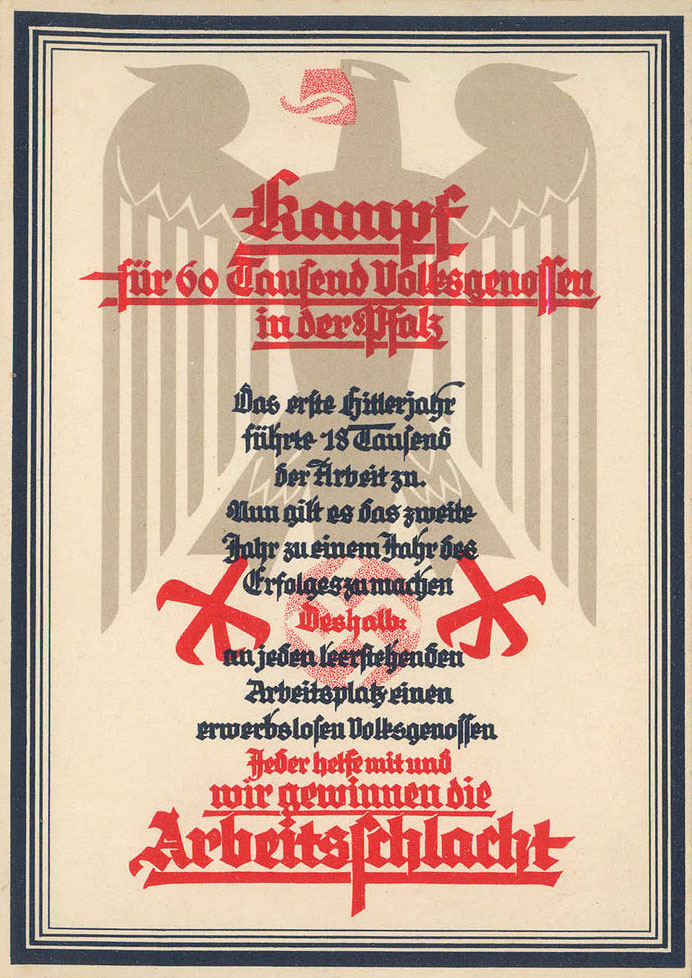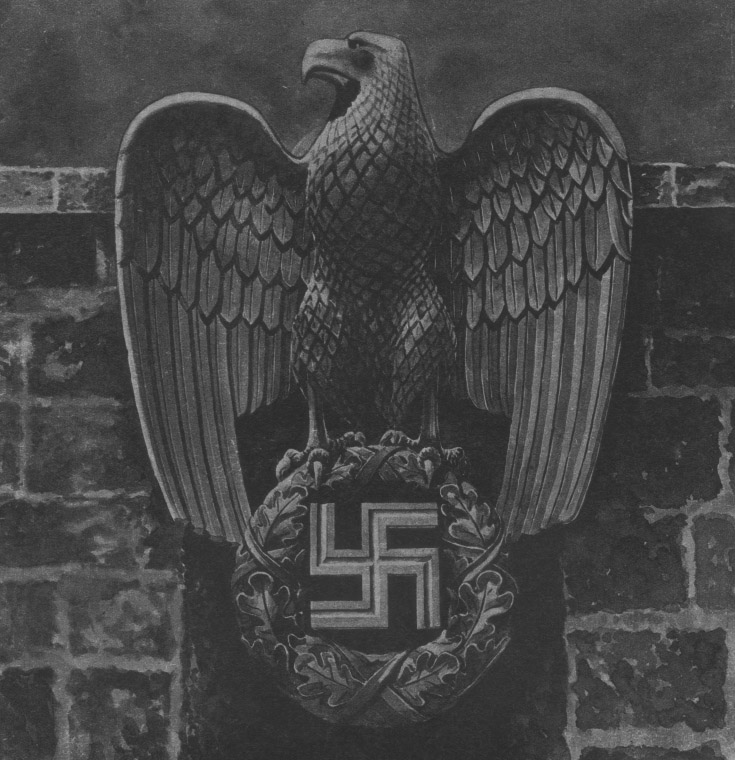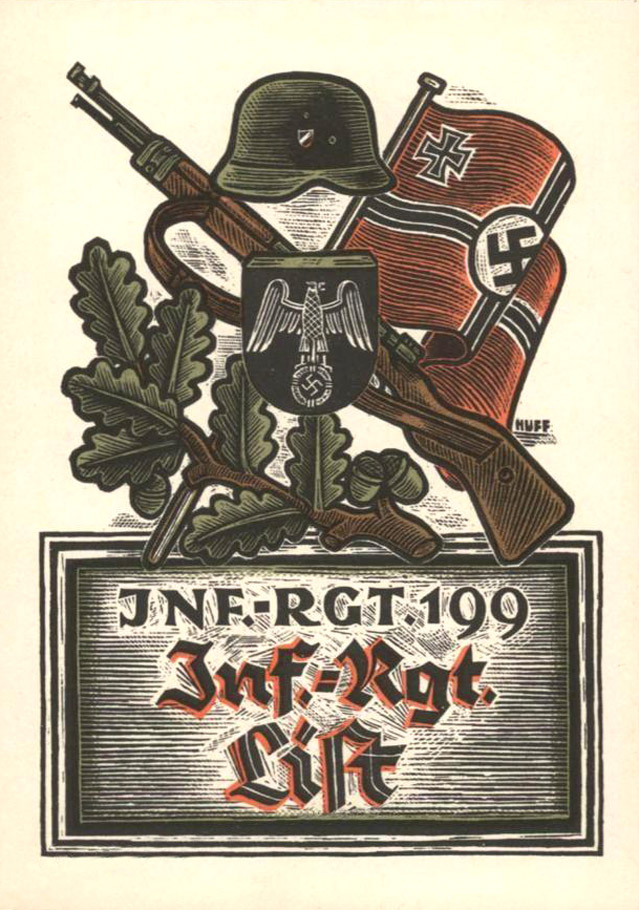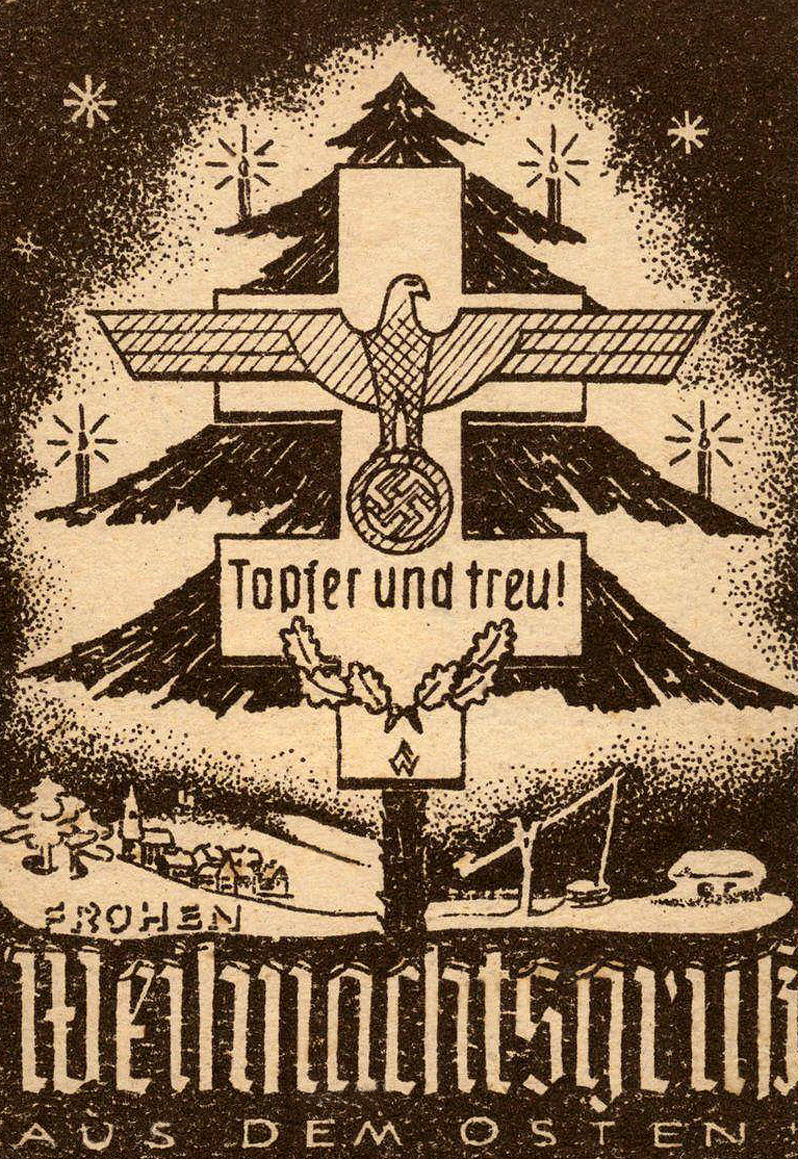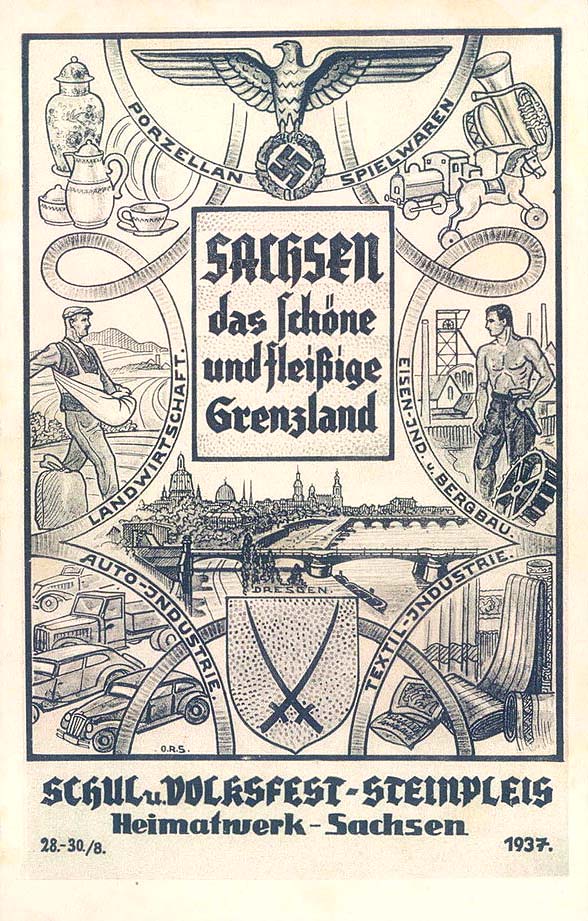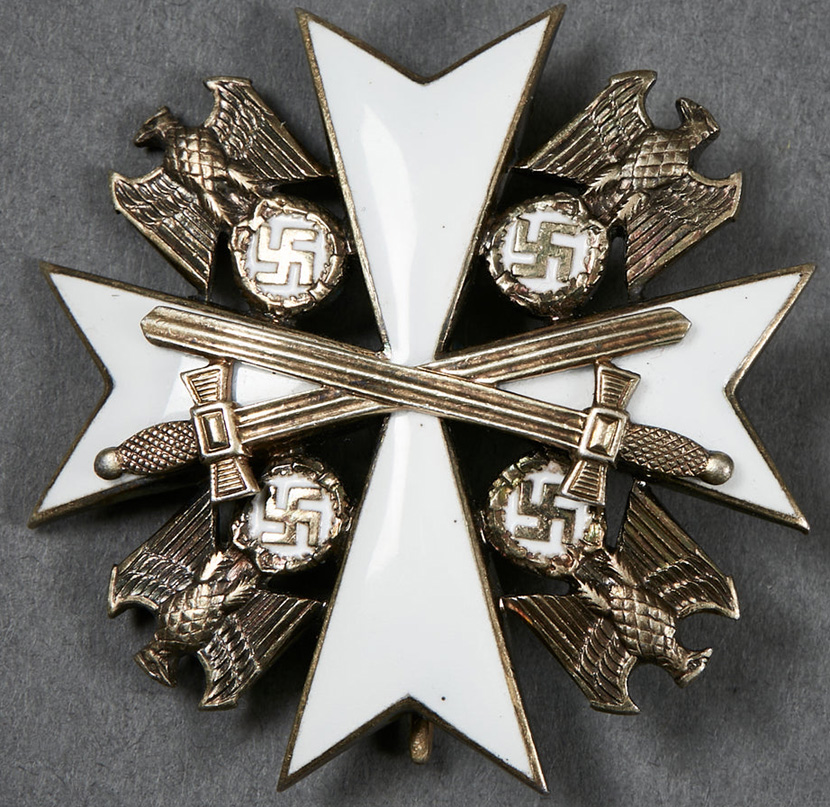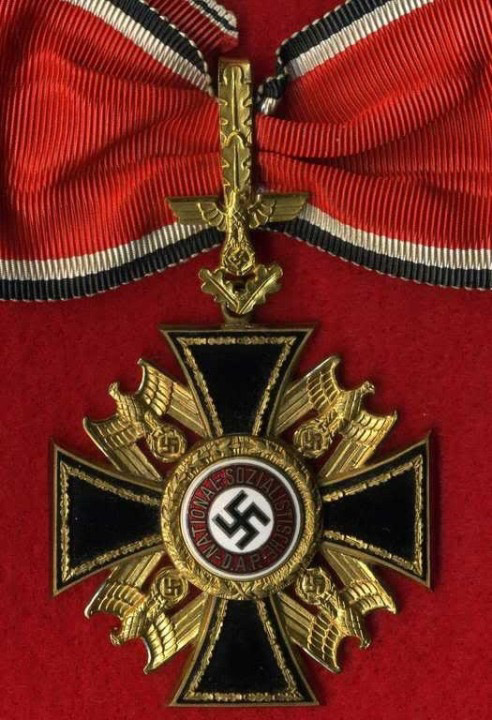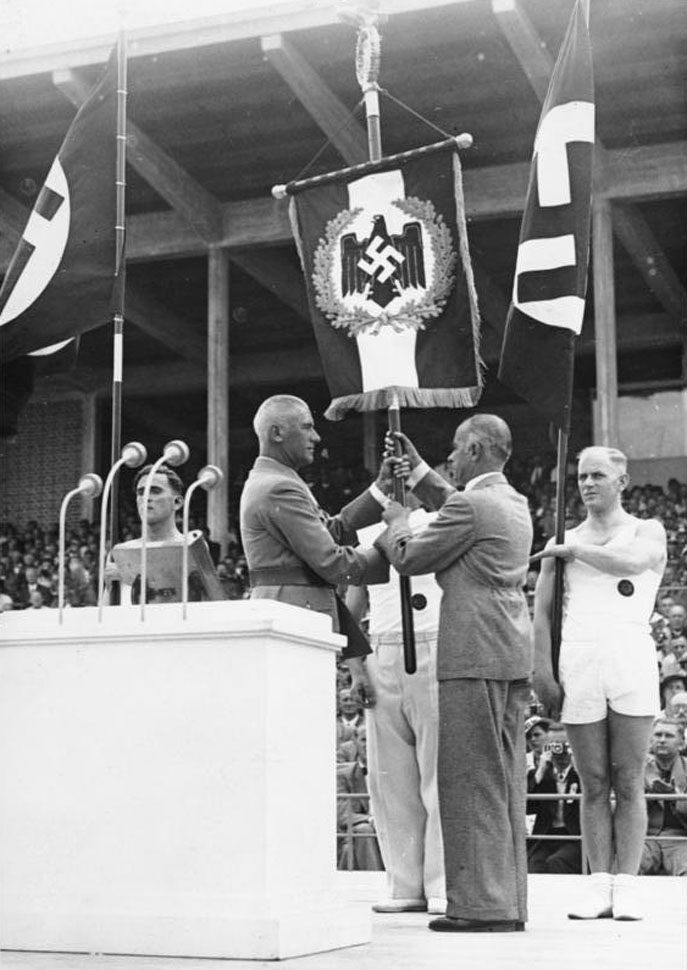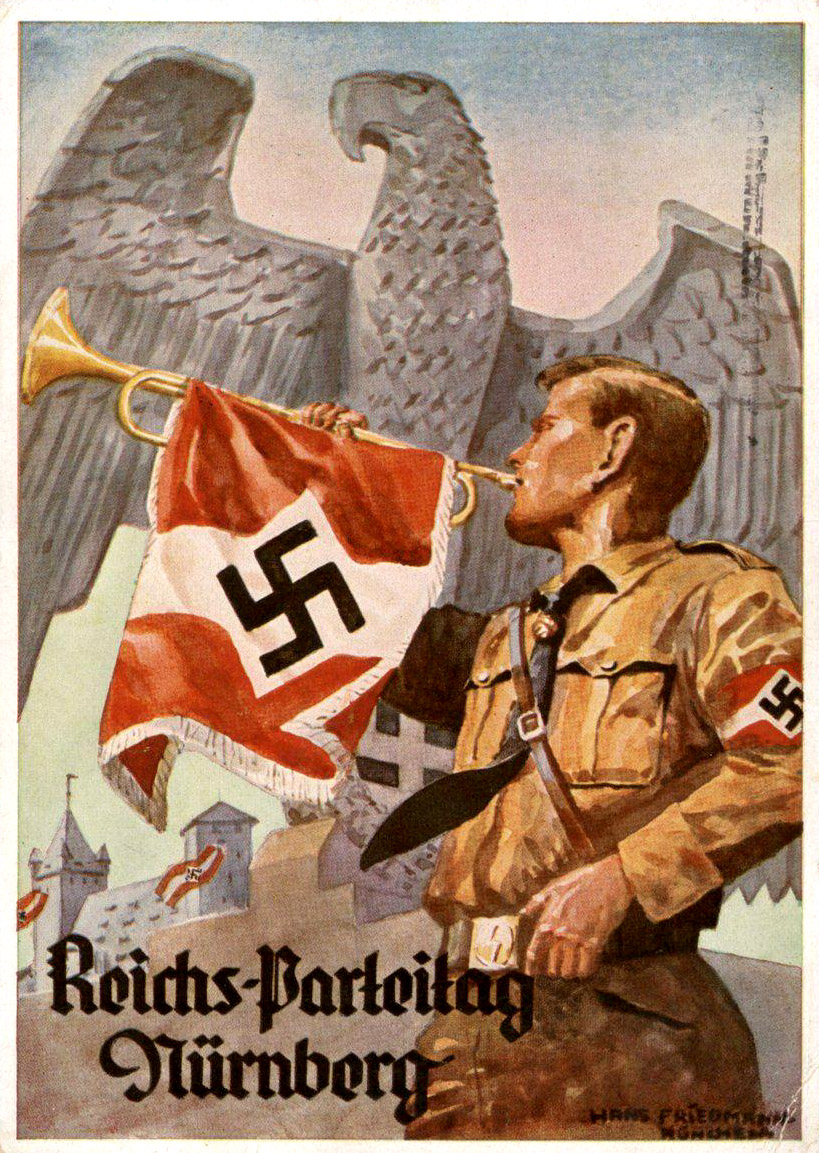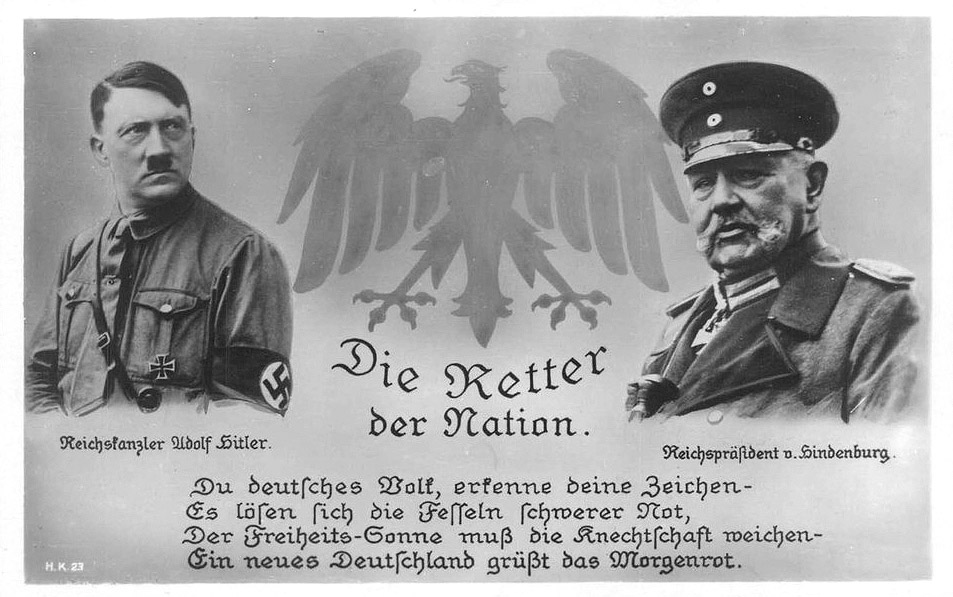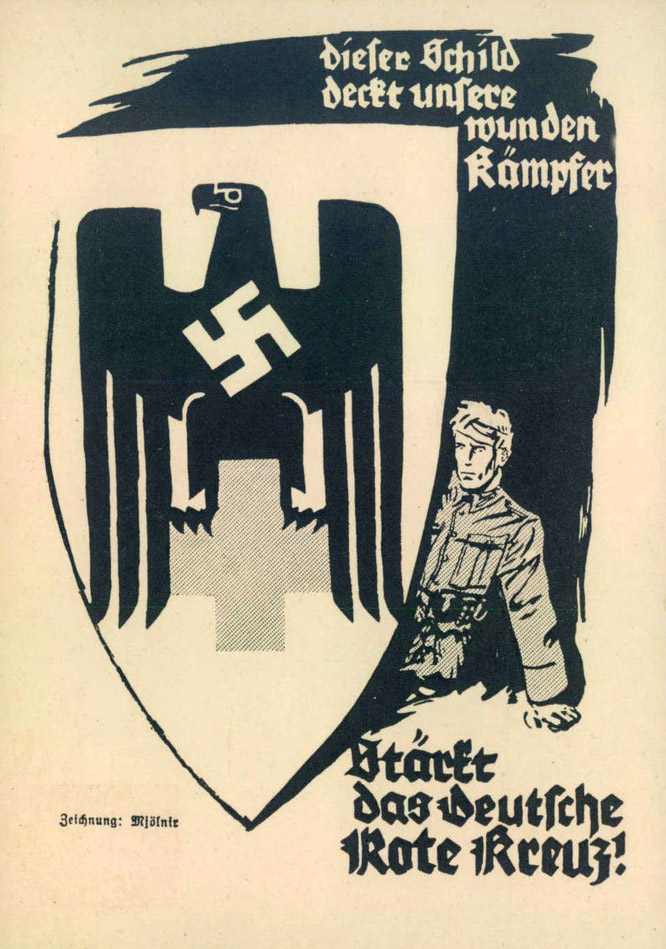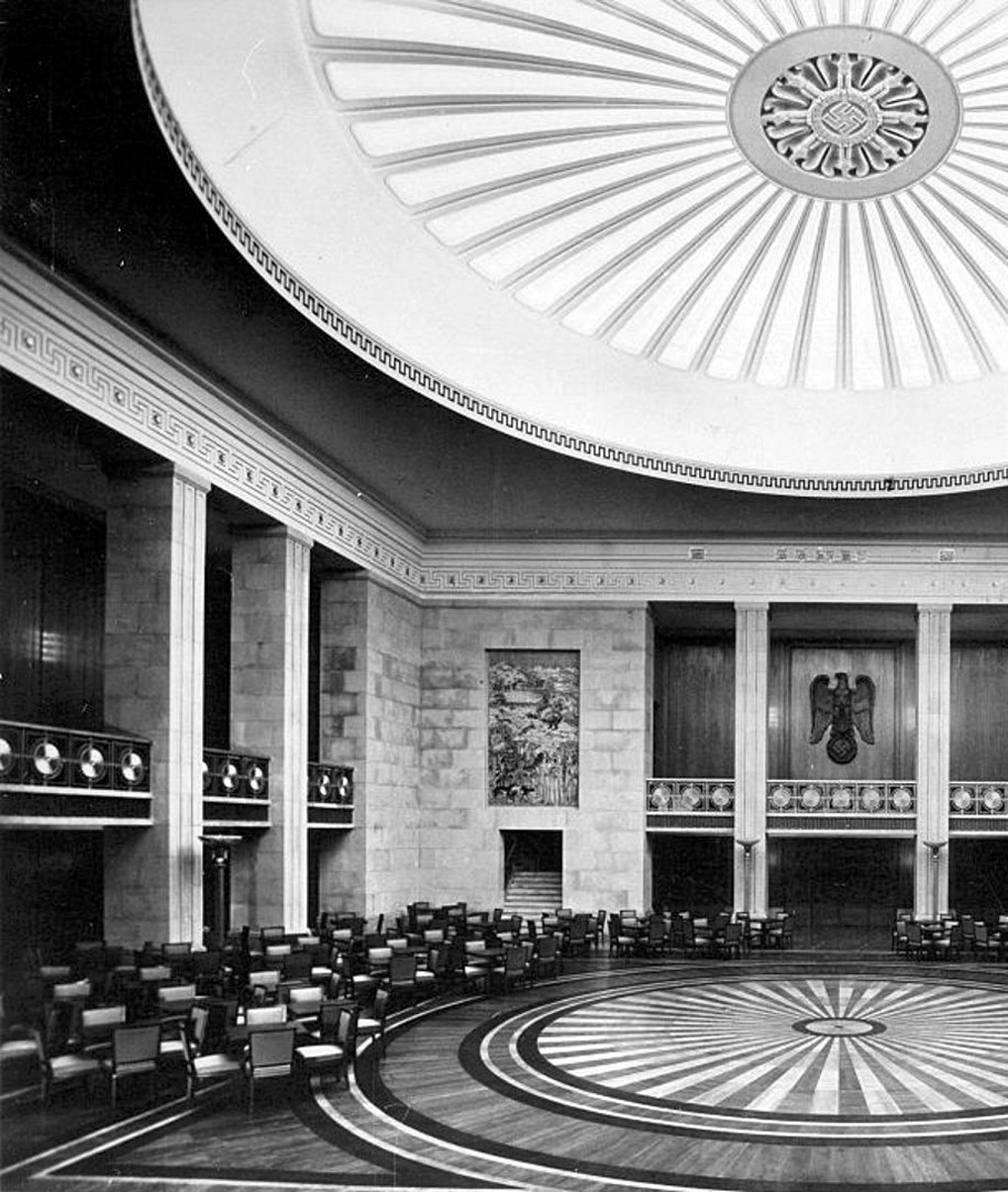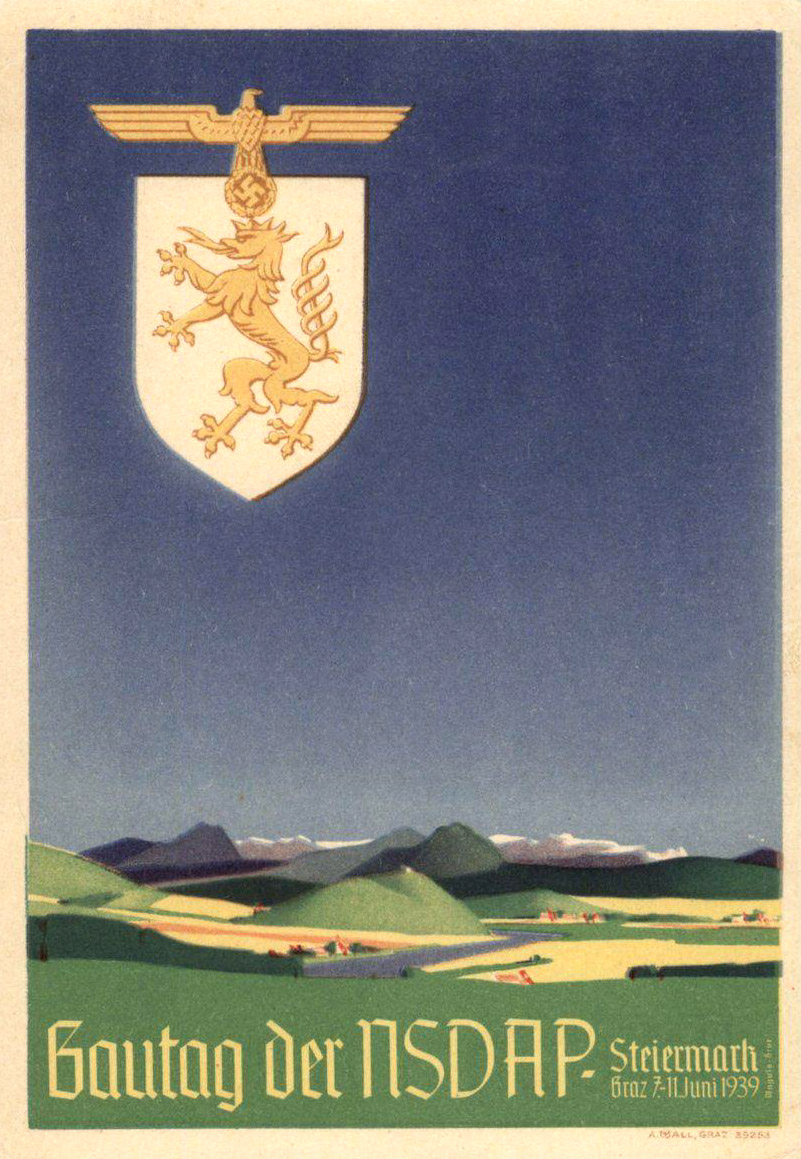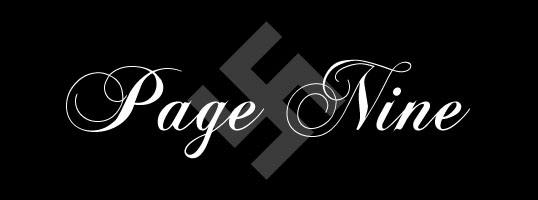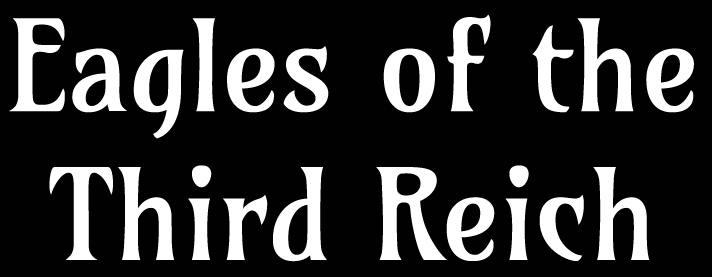
[Below: Wow, very cool...]
[Below: Now that's a great workplace atmosphere. Seidler means 'silk weaver'.]
[Below: Now that's an alarm clock! This is one of many cool souvenirs sold during the 1936 Olympics.]
[Below: Here's a very pricey and rare early postcard for the 1933 Nuremberg Reichsparteitag. This shows where Adolf Hitler gave a speech Nuremberg town square.]
[Below: '4. Reichskleingärtuertag Wien' (Reich 4th Leisure Gardeners Day Vienna) from June 28th to July 2nd 1939. On the bottom right we see that the great Richard Walther Darré was involved with this, since he was the leader of the organization Blut und Boden (Blood and Soil) and served as the Reich Minister for Food and Agriculture.]
[Below: 'Berlin - Die Ost-West-Achse im Festschmuck' (Berlin - The East-West Axis in Festive Decoration). It must have been something grand being there, seeing history unfold like never before. A people unbridled by the evil corruption of this world.]
[Below: The unimaginably corrupt Treaty of Versailles basically took away Germany's right to defend herself. Perhaps they wanted Germany to be defenseless when the communist invasion of Europe came about (which Operation Barbarossa prevented). It limited Germany's standing army to a piecemeal force and banned its airforce and most weapons. Here was a parade showing that Germany had broken its chains and had grown its teeth back.]
[Below: This is a very neat postcard where the image is made from embroidered silk. It shows the Munich 'Mahnmal' (memorial/monument) to the November 9, 1923 martyrs of the National Socialist Putsch.]
[Below: Another postcard from embroidered silk, obviously from the same manufacturer. Okay it doesn't have an eagle, but you'l forgive me because it belongs with the above. It shows the Koenigsplatz, which, among several important locations, housed the memorials to the war dead and the Honor Temple which enshrined the remains of the November 9, 1923 martyrs of the National Socialist Putsch.]
[Below: A Hitler Youth rally showing the side of a very cool looking eagle.]
[Below: This KdF (Kraft durch Freude), or Strength Through Joy) postcard says 'Waffensoldatentum und politisches Soldatentum -- die Stäke unseres Volkes.' (Armed soldiering and political soldiering -- the strength of our people.)]
[Below: This postcard, in the set of that above, says '"Deutschland erwache!" Saalbau friedrichshain -- die alte kampfstätte der Partei!.' ("Germany awake!" Saalbau Friedrichshain -- the Party's old battle site!). Saalbau Friedrichshain is a locale in Berlin described now as 'celebrating multiculturalism'.]
[Below: This vignette stamp says 'Ins Dritte Reich! National Sozialisten' (To the Third Reich! National Socialists).]
[Below: This wooden relief says 'Unser Volkskanzler 1933' (Our People's Chancellor 1933).]
[Below: An interesting image of soldiers on an armored vehicle with a homemade eagle and swastika flag. This was done to identify you to flying forces.]
[Below: This postcard says 'hier sprach 1933 der Führer - Treffen Zur Erinnerung an den entscheidungs wahlsieg in Lippe.' (The Führer spoke here in 1933 - Meeting in memory of the decisive election victory in Lippe). Lippe is a district in the east of North Rhine-Westphalia, Germany.]
[Below: A German honor guard stands before the 'Denkmal des Gallischen (French) Triumphes' in Compiègne. (Monument to the Gallic Triumph). Compiègne is in Northern France. This is a 1918 Alsace-Lorraine monument, depicting a German Eagle impaled by a sword. After France's defeat the Germans placed a National Socialist flag above the eagle! Haha! Courtesy of the Bundesarchiv.]
[Below: A modern photograph of the monument.]
[Below: Book cover of 'Kurzgefasste Geschichte des Nationalsozialismus von Dr. Johann V. Leers' (Concise History of National Socialism by Dr. Johann V. Leers). Leers was a lifetime NS fighter, writing truth for many years after the war in exile.]
[Below: A powerful eagle on this postcard advertising a sports tournament in Breslau in 1938.]
[Below: Here is another postcard from the set above.]
[Below: Here's a rather uncommon 1938 postcard. It says 'Gautreffen Pommern der NSDAP Stettin' (NSDAP Pomerania district meeting Stettin). Stettin is a city in Pomerania, which is now a part of Poland since the land grab after WWII.]
[Below: 'Berlin, Unter den Linden im Festschmuck' (Berlin, Unter den Linden in festive decorations). Unter den Linden is a famous boulevard in Berlin. It is named after the linden trees that line it. So it means 'Under the linden trees'. Terrible battles were fought here just days before the end...]
[Below: A marvelous tinnie (these are also called day badges. There was a massive variety of these produced during the 3rd Reich. They were made from a wide range of materials, like paper, glass, bakelite, leather, ceramic, plastic, wood and all varieties of metal. This example is pricey, like everything SS). This tinnie tells of a march on May 10-11, 1933.]
[Below: This is such a cool group shot of early National Socialists in the Braun Haus (Brown House). In the middle row, third from right, is the famous Jakob Grimminger, the holder of the holy Blood Flag of the 3rd Reich. When you see videos of Adolf Hitler walking with a flag, grasping its corner and touching other flags with it, he is in fact touching each new flag with the Blood Flag, embuing each new flag with its spirit. The Blood Flag, if you don't know, was splashed with the blood of martys whom died in the 1923 Putsch. This magical flag was never found after the war. You can be sure it is safe in the hands of National Socialists, ready to reappear one day and share its power and mystique.]
[Below: Here's a famous photo of Adolf Hitler grasping the Blood Flag in a flag blessing ceremony.]
[Below: This is a rather rare postcard, it says 'Dein Opfer ein Schritt zum Sieg' (Your Donation, a Step to Victory). This is a 1941 Kriegswinterhilfswerk (War Winter Relief) postcard.]
[Below: Here's a period framed photo of Adolf Hitler which has been autographed and enscribed.]
[Below: 'Ostdeutsche Kulturtage 1941 - 16.-23. März Reichsgau Warthelandart' (East German Culture Days 1941 - March 16-23 Reichsgau Wartheland).]
[Below: The sign says 'Kommando des Flughafenbereichs Warschau' (Headquarters of the Warsaw airport area).]
[Below: Here's a ticket from the 1939 Reichs Party Day. It is so cool to see these tickets to the extraordinary pictures we see. It says '1939 Reichsparteitag Einlasskarte - zur Tagung des hauptamtes für kommunalpolitik - am 6. September 1939 in der Kongresshalle' (1939 Reich Party Congress admission ticket - to the meeting of the main office for municipal politics - on September 6, 1939 in the Congress Hall). As you can kinda see, the top art is embossed.]
[Below: Reichs Party Day postcard.]
[Below: 1937 Reichs Party Day postcard.]
[Below: Cancel to the 1937 Reichs Party Day postcard above.]
[Below: 1935 Reichs Party Day postcard. It says 'Deutsche Einheit - Deutsche Macht!' (German Unity - German Power!).]
[Below: Reichs Party Day postcard. It says 'Stadt der Reichsparteitage Nürnberg' (State of the Reichs Party Day Nuremberg).]
[Below: A cool picture! This person is from the RLB (Reichsluftschutzbund, or Reich Air Protection League) and is taking donations for the WHW (Winterhilfswerk des Deutschen Volkes, or Winter Relief of the German People).]
[Below: This 1937 postcard is from the NSFK (Nationalsozialistisches Fliegerkorps, or National Socialist Flyers Corps. On the postcard reverse it says 'Deutschland für immer stärkste Luftmacht der Welt' (Germany forever the strongest air power in the world).]
[Below: This rare beauty of a postcard says:
(Freedom
[Below: This postcard says '1.Reichs-Theaterfestwoche' (1st Reichs Theater Festival Week) Dresden, May 1934.]
[Below: Here is a vertical version of the postcard above. These are neat looking postcards.]
[Below: This advertising vignettte stamp says 'Grosse Deutsche Funf-Ausstellung Berlin 1934' (Fifth Great German Exhibition Berlin 1934).]
[Below: This art postcard was done by 'Graphische Kunstanstalt' (Graphic Art Institute).]
[Below: The entrance doors to the gorgeous New Reich Chancellery in Berlin, 1939.]
[Below: Men from the DAF (Deutsche Arbeitsfront, or German Labor Front) in front of the Reich Chancellery. You can tell that they are DAF by the cogwheel on top of the flag poles.]
[Below: This is the Restaurant inside the Lambach Inn on Lake Chiemsee, Bavaria, said to be Adolf Hitler's favorite Inn in the early days. This is a Heinrich Hoffmann photo.]
[Below: The outside of the Lambach Inn on Lake Chiemsee.]
[Below: This neat postcard is from the Vienna Electric Company and is honoring the soldiers at the front.]
[Below: This is a cool looking postcard issued by Heinrich Hoffmann celebrating not only Adolf Hitler's 50th birthday but his many stellar accomplishments up until 1939.]
[Below: Berlin in 1937... before the warmongers had their way. Leon Degrelle, one of the strongest and most loyal men who ever lived, said it best:
'In this world the most beautiful things know the worst fate.'
(Léon Degrelle in Exile (1945 - 1994), pg. 174, ©2022 José Luis Jerez Riesco, Translated by Jason Rogers, Antelope Hill Publishing {originally published in Spanish in 2009})]
[Below: 'Grossdeutschlands Winterhelfswerk 1939/40' (Greater Germany's Winter Relief Work 1939/40).]
[Below: NSDAP songbook. Sorry the picture is so small, but the eagle is a neat one. 'Das Lied der Deutschen' (The Song of the Germans).]
[Below: Such a strange, rather abstact work. Even the colors are unlike anything I've really seen from postcards of the era. The outline of the eagle and the bayonet are oddly very sharp as well. The theme, however, was commonly expressed in the 3rd Reich.]
[Below: Here's an organization that isn't talked about or really known about today. It is the RDF (Reichsbund Deutsche Familie, Kampfbund für erbtüchtigen Kinderreichtum, or German Family Reich's League, Struggle League for a Hereditarily Strong Offspring). The RDF was an organization that promoted marriage and having children (at least four children). It was ran by a man named Dr. Rober Kaiser, of whom there is very little information available of unfortunately. Also note the little hatchlings beneath the 'mother' bird on the pin.]
[Below: This postage stamp celebrates 10 years of Winterhilfswerk, issued on September 1, 1943.]
[Below: The eagle of the RDF. Definitely one of the rarest official eagles of the 3rd Reich.]
[Below: Here is an interesting page from an official NSDAP book from 1943 explaining some of the organizations in the Reich.]
[Below: Okay, borrowing two pictures from page two, here is an actual document from the RDF that came with a Mein Kampf given to a young couple upon their marriage.]
[Below: Close-up. Note the Algiz rune - meaning life, beginning and also protection.]
[Below: Here is a ultra cool postcard that has been colorized by a modern artist. I normally don't really care for colorized stuff but whoever did this did a fabulous job.]
[Below: This is an advertising vignette stamp, it says 'Reichs-Handwerks-Woche - Fördert das Handwerk!' (Reichs-Trades-Week - Promotes the Trade!)]
[Below: This postcard, which bears two pretty neat eagles, says 'NSLB Reichstagung' (NSLB Reich Conference). The NSLB is the National Socialist Teachers League (Nationalsozialistischer Lehrerbund), Frankfurt, 1934.]
[Below: The eagle of the NSLB - I love the wing design.]
[Below: Borrowed from page three, here is the face of a pin from the NSLB.]
[Below: Wow, this is neat. I'm not sure exactly how this was awarded, but the 5,000 apparently stands for 5,000 kilometers. Maybe this was taken off of a plaque?]
[Below: Now this is a powerful poster/eagle. 'Deutschland Erwache!' (Germany Awake!). This is an early election poster.]
[Below: This is a rally celebrating the 2nd anniversary of the incorporation of Wartheland into the Reich, 1941. Wartheland was a region annexed from Poland in 1939. Look at all those eagle flag toppers... Courtesy of the Bundesarchiv.]
[Below: Is this a neat looking postcard or what? From 1934, it says '14. Parteigründungstag - Dem Führer die Treue! (14th Party Foundation Day - Loyalty to the Führer!) The hand symbol is a traditional way of swearing an oath dating back centuries.]
[Below: Here are two examples of soldiers swearing oaths to the Führer as part of their initiation ceremony into the German Armed Forces.]
[Below: Here is an official envelope from a regional Hitler Youth office in Austria, March 1941. It is sent registered, as you can see by that label on the upper right with the big 'R'.]
[Below: Eagle close-up.]
[Below: This postcard shows the sculpture 'Genius of Victory' by sculptor Adolf Wamper at an art exhibition in Munich, 1940.]
[Below: A strange eagle design used for the 1936 Berlin Olympics. It looks cooler in the next photo.]
[Below: This is cool! A photo of the actual Olympic bell. It looks like the photo has been touched up a bit, doesn't it? The eagle looks kind of strange. This was a normal practice before publication back in the day.
[Below: Another Olympic postcard. It says 'Zur Ehre des Vaterlandes - Zum Ruhme des Sports' (To the glory of the fatherland - To the glory of sport).]
[Below: And a final Olympic poscard for you.]
[Below: An Adolf Hitler relief with a crooked swastika!]
[Below: Check out this collar tab... ! It is from the uniform of none other than Reichsminister Alfred Rosenberg!]
[Below: This is a neat postcard. It shows German communications soldiers with a field phone/headset.]
[Below: Another from the set above. It shows the Vienna city silhouette and is from the National Electrics Club.]
[Below: I don't know much about the structure in this photo other than it is celebrating the Anschluss with Austria.]
[Below: This postcard celebrates the Anschluss with Austria (which the Germans called 'Ostmark'), the reclaimation of the German territory of Sudetenland (Sudetengau). January 30 is the date that Adolf Hitler became chancellor.]
[Below: This is from German occupied Poland, Krakau, March 1941. It says 'Deutsche Kunstler Sehen Das Generalgouvenement' (German Artists See the General Government). The 'General Government' was the official name the Germans gave Poland after the occupation. It is on stamps, money, everything. Courtesy of the Bundesarchiv.]
[Below: This is a donation postcard toward the freedom of the German Rhineland. It says:
'Kampf (Struggle
[Below: Pretty neat. I like the swastika, it reminds me of the swastika on the Adolf Hitler Standarte.]
[Below: Unit postcard for Infantry Regiment 199. Cards that state certain regiments like this are usually of low print numbers due to their limited appeal, thus much rarer today.]
[Below: 'Tapfer und treu! - Weihnachtsgruß aus dem Osten' (Brave and faithful!
Christmas greetings from the East) This postcard was produced by the men in the field, from Infanterie-Regiment 208, somewhere in Russia shortly after the Battle of Kharkov. Sadly, the regiment was completely destroyed the following winter in Stalingrad.]
[Below: This August 1937 postcard says 'Sachsen das Schöne und Fleißige Grenzland -
Schul u. Volksfest - Steinpleis - Heimat - Sachsen
' (Saxony the Beautiful and Hardworking Borderland -
School and folk festival - Stonecutter - Homeland - Saxony).]
[Below: This is so incredibly beautiful. It is made of .900 silver (90% silver - Germany traditionally used .800 silver) and is called The Order of the German Eagle, 5th Class 1943-45 (Deutsche Adlerorden Fünste Klasse). This style of medal was issued with and without swords and also on a traditional ribbon and a neck ribbon.]
[Below: This marvelous medal is simply called The German Order (Deutsche Orden).]
[Below: A gorgeous NSRL (Nationalsozialistischer Reichsbund für Leibesübungen, or National Socialist League of the Reich for Physical Exercise) flag!).]
[Below: Okay, this postcard is from 1924, but I liked the eagle! It says 'Flieger Gedenk Tag' (Airman Memorial Day).]
[Below: This 1935 Reichs Party Day postcard shows a young man from the Hitler Youth.]
[Below: This postcard, with images of Adolf Hitler and Hindenburg, says 'Die Retter der Nation' (The Saviors of the Nation).]
[Below: One of the coolest eagles of the 3rd Reich, and on a Red Cross postcard of all things. This says 'Hilf Im Deutsche Roten Kreuz' (Help in the German Red Cross).]
[Below: Another Red Cross postcard, this says 'Dieser Schild deckt unsere wunden Kämpfer - Stärkt das Deutsche Rote Kreuz!' (This shield covers our fighters' wounds -
Strengthen the German Red Cross!). Also of note, you'll see the word 'Mjölnir' at the bottom left of this postcard. This is of course the name of Thor's hammer. But in this case, it is also the name of one of the 3rd Reich's greatest artists. His real name was Hans Schweitzer (July 25, 1901 – September 15, 1980). He produced many works for National Socialism, from posters to postcards and everything in between. He was also a very early National Socialist artist, some of his early postcard works can be very rare and expensive.]
[Below: Wow... is this a hall in Valhalla? At first glance you see the eagle on the wall in the background... but look closer at the swastika on the ceiling -- it's also surrounded by eagles!]
[Below: This 1939 postcard advertises the Day of the NSDAP in Steiermark. Steiermark is a state in southeast Austria. I like the calmness and simplicity of this postcard.]
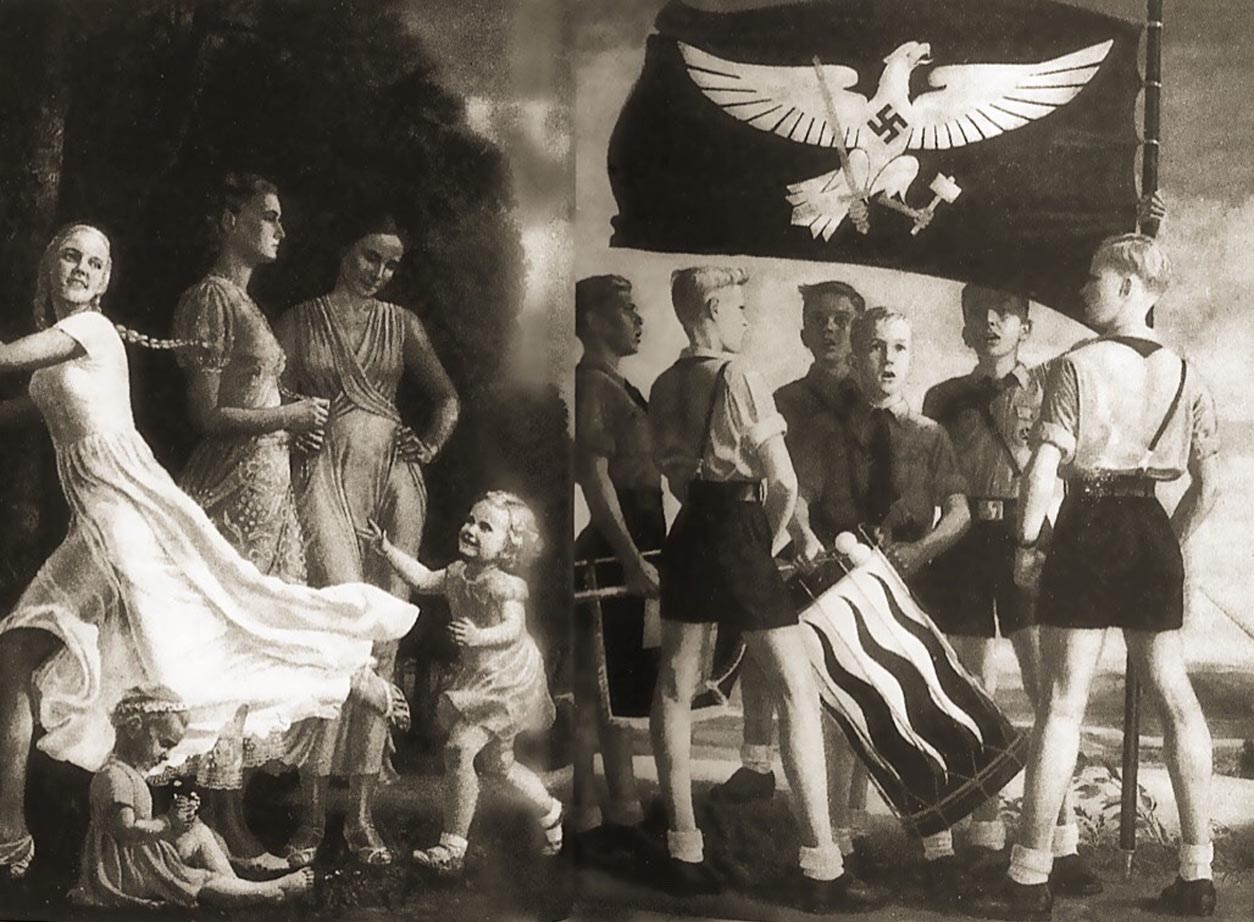
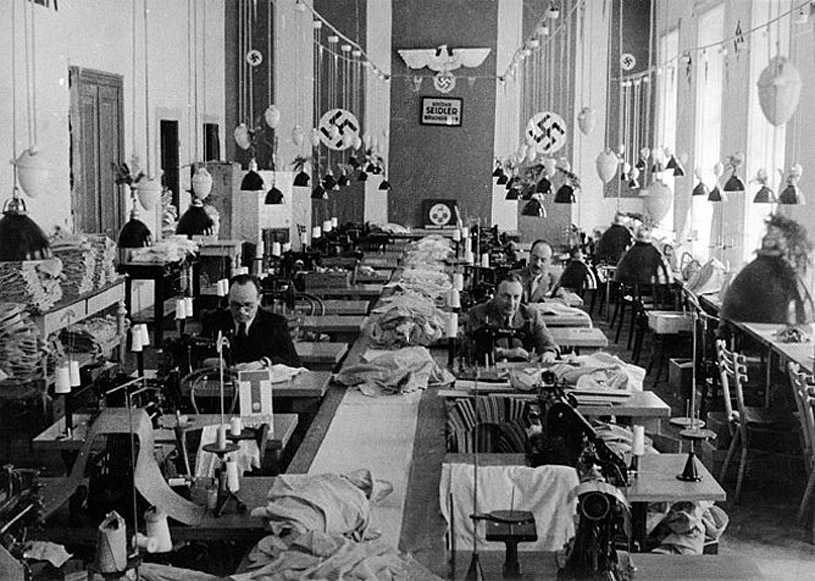
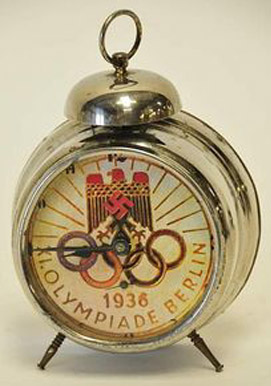
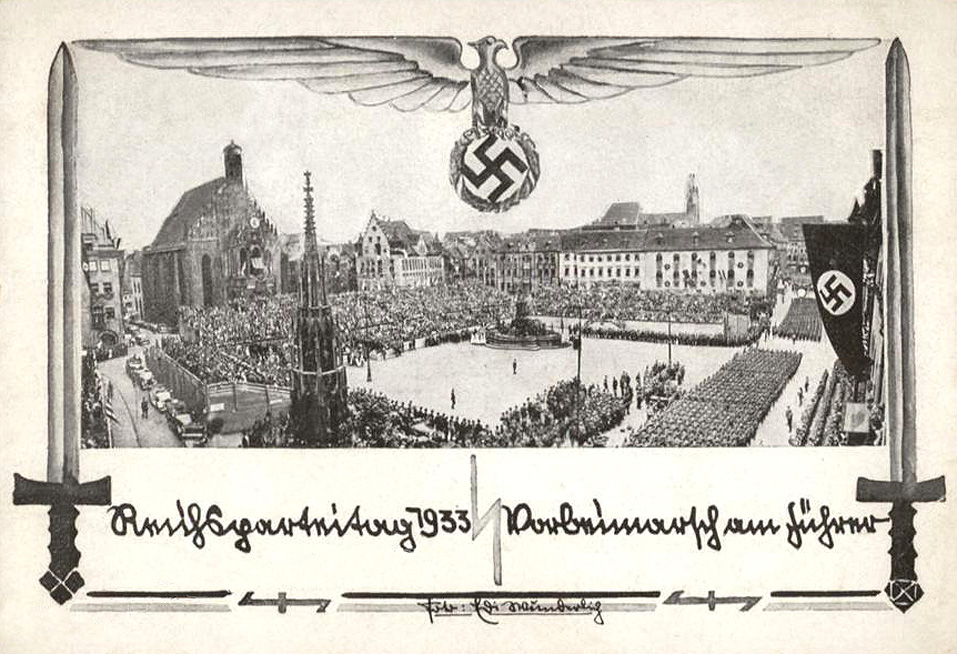
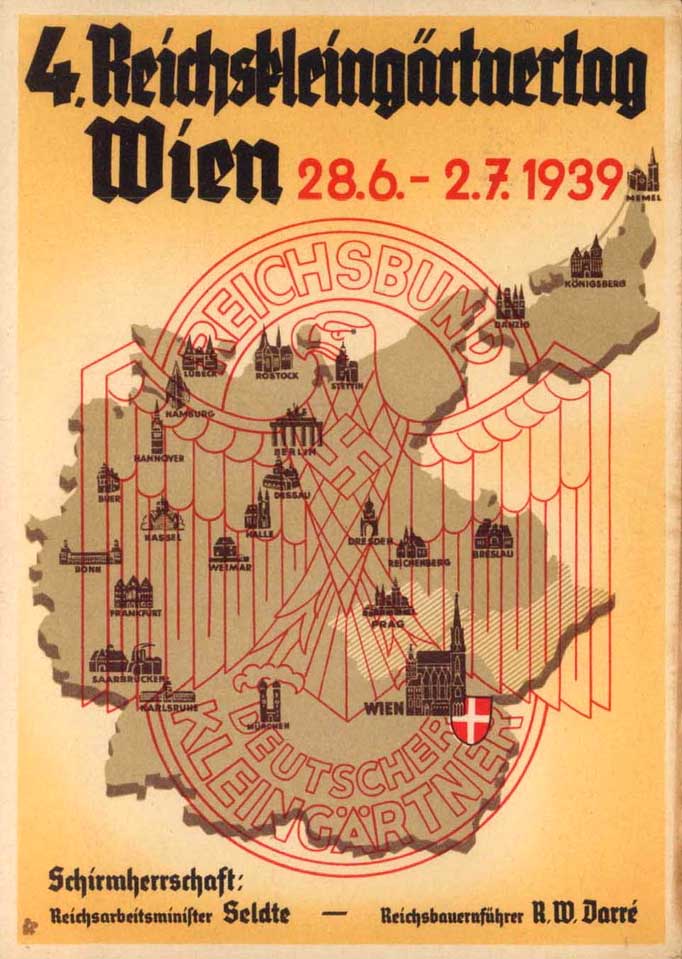


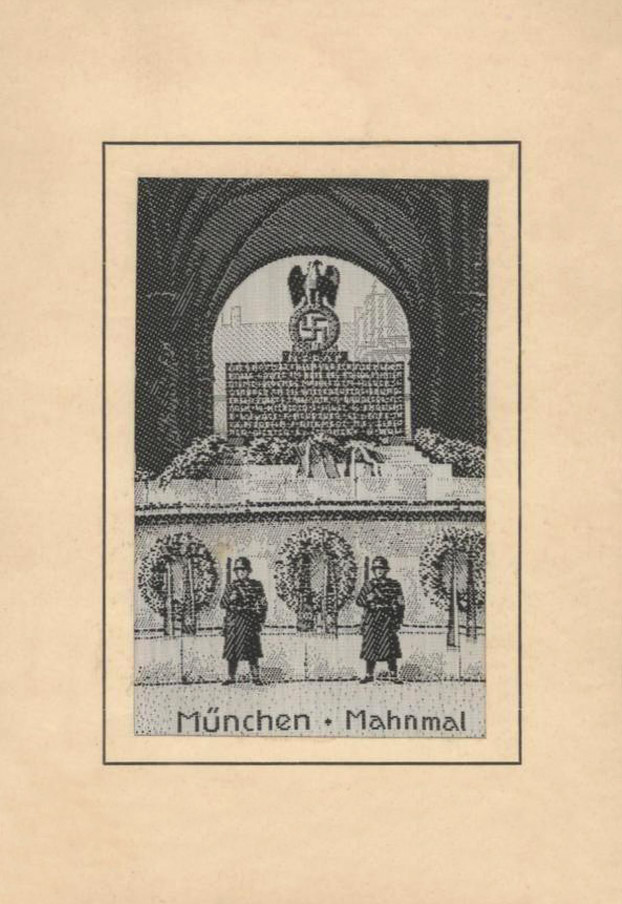
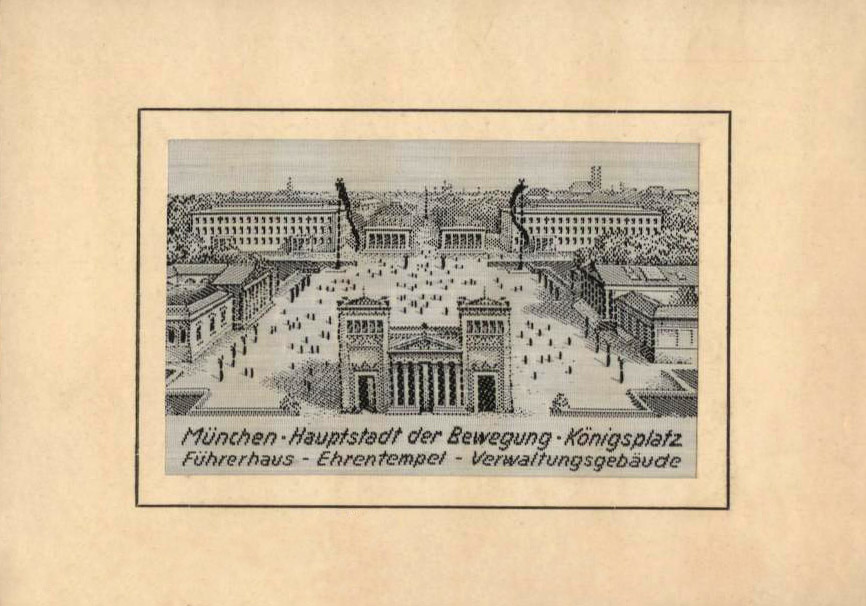
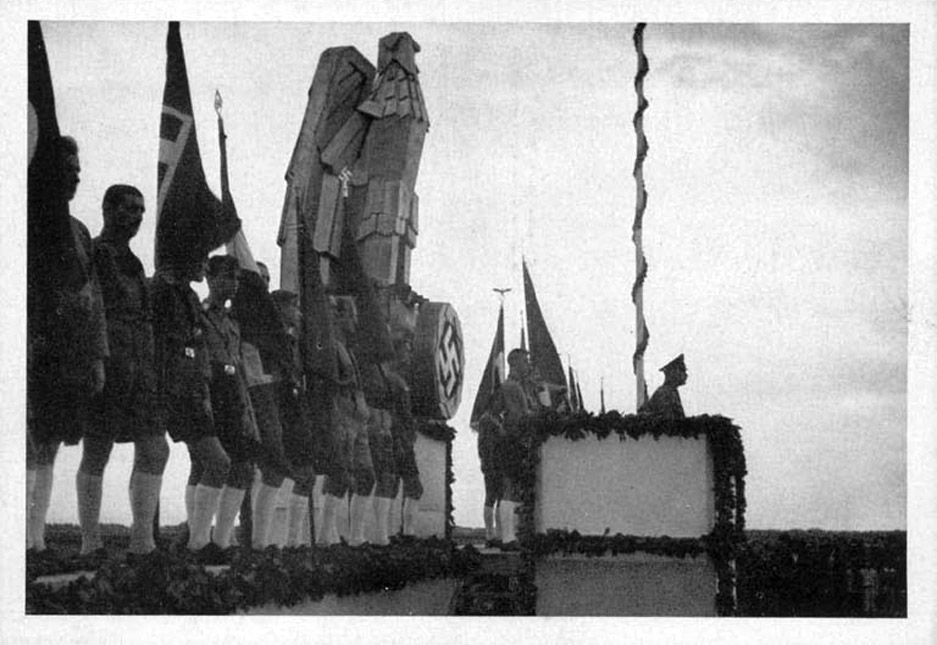
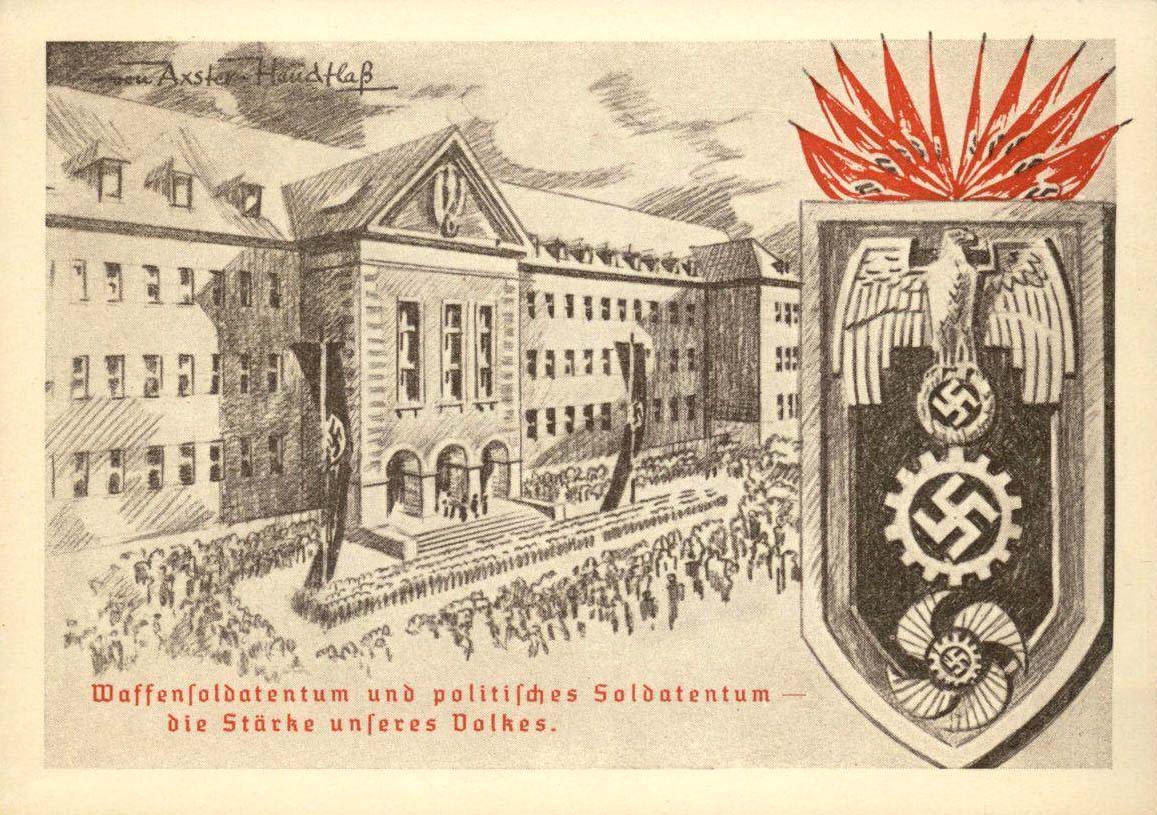
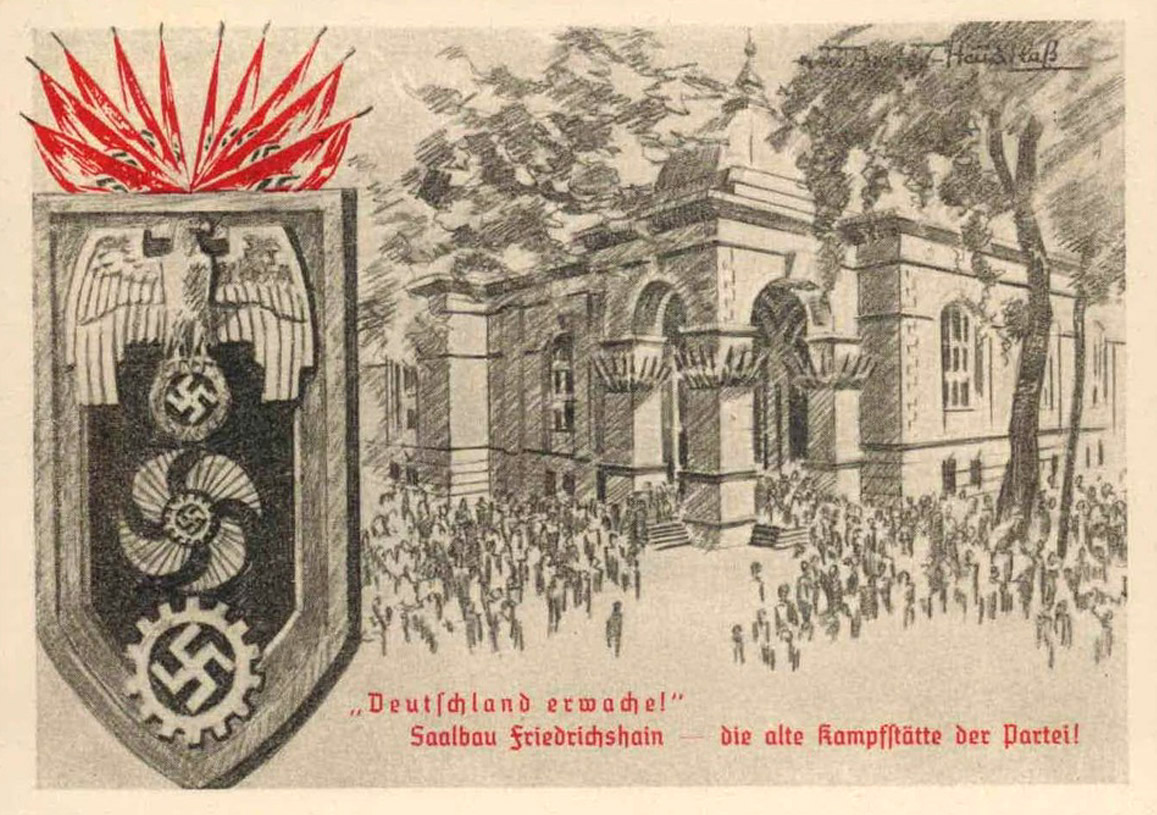
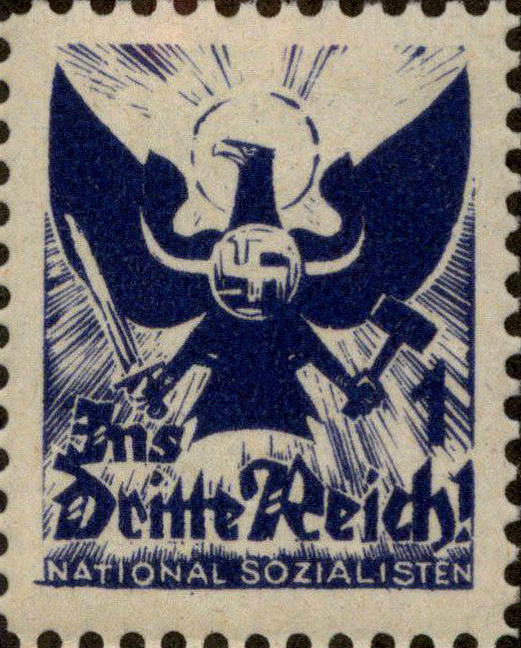
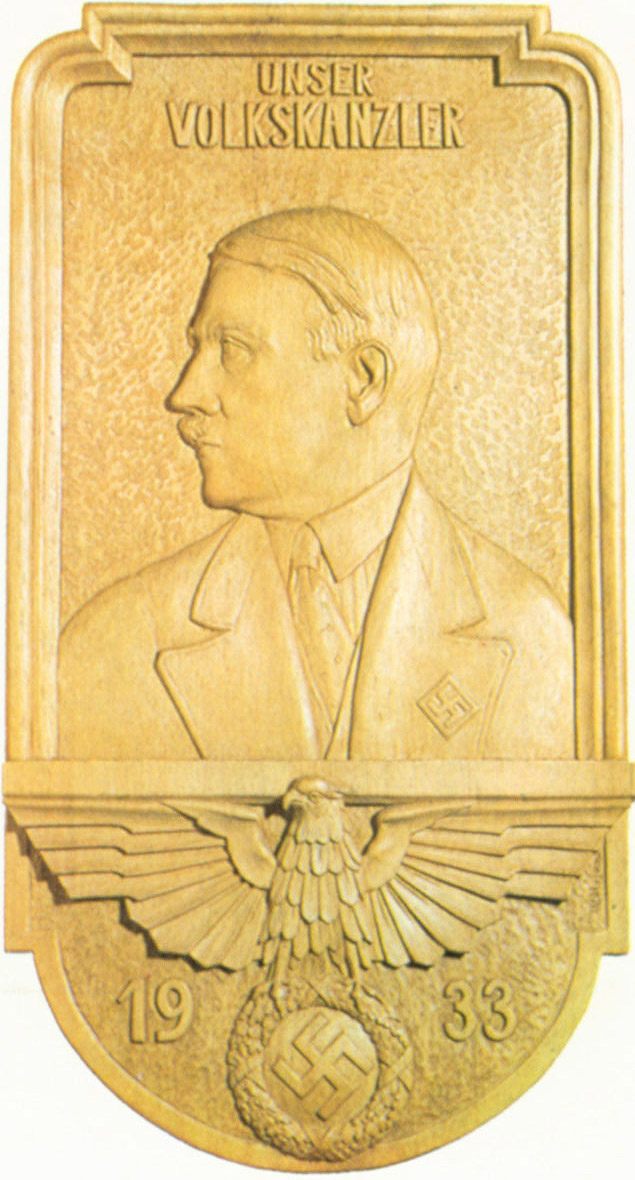

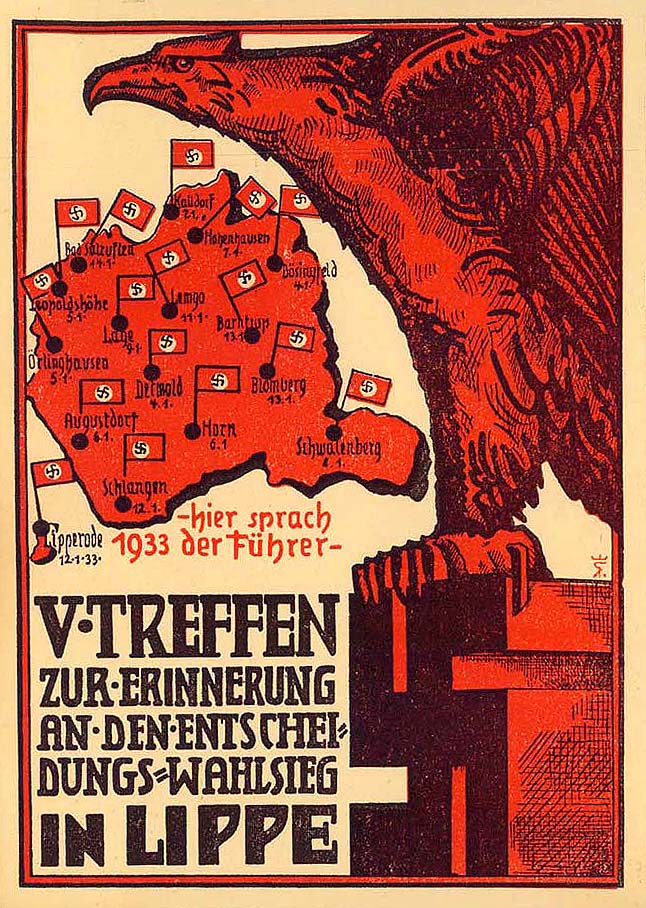

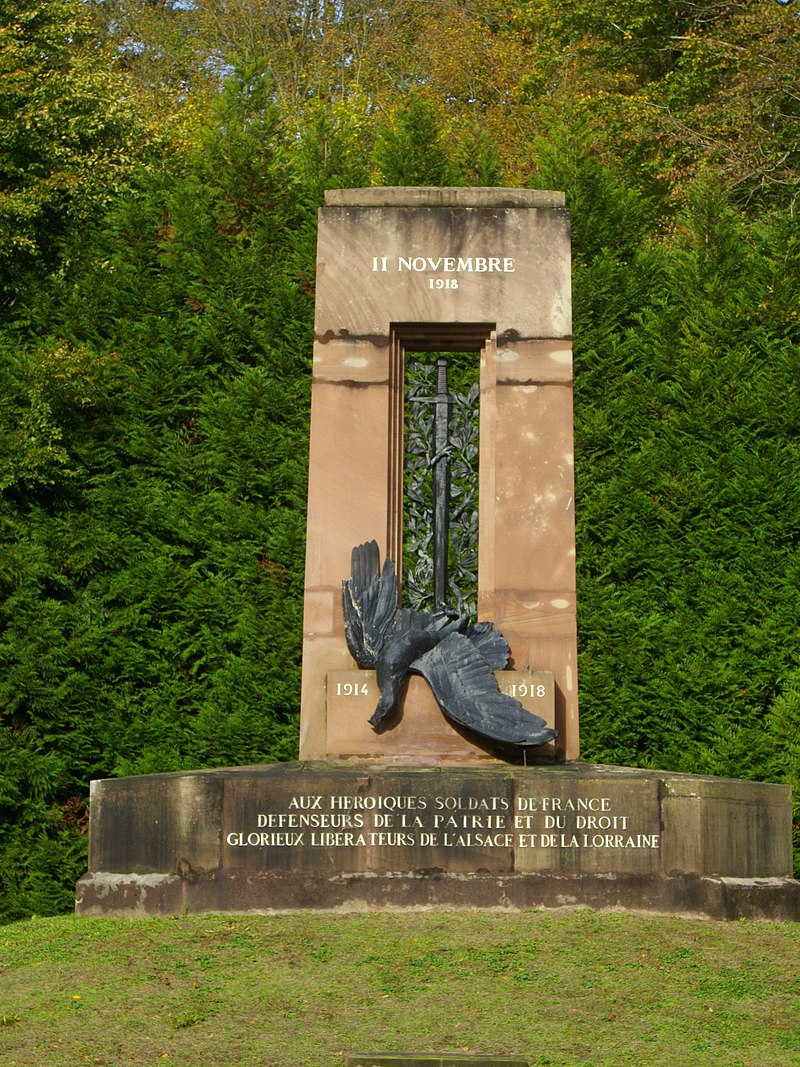
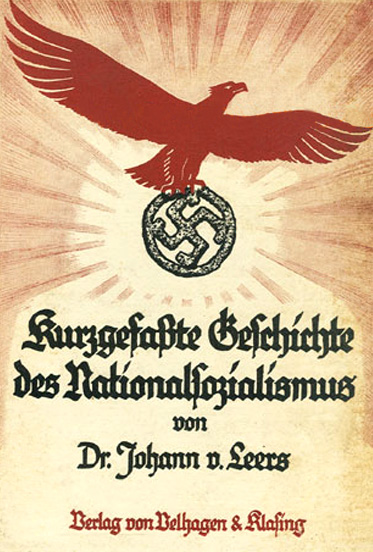
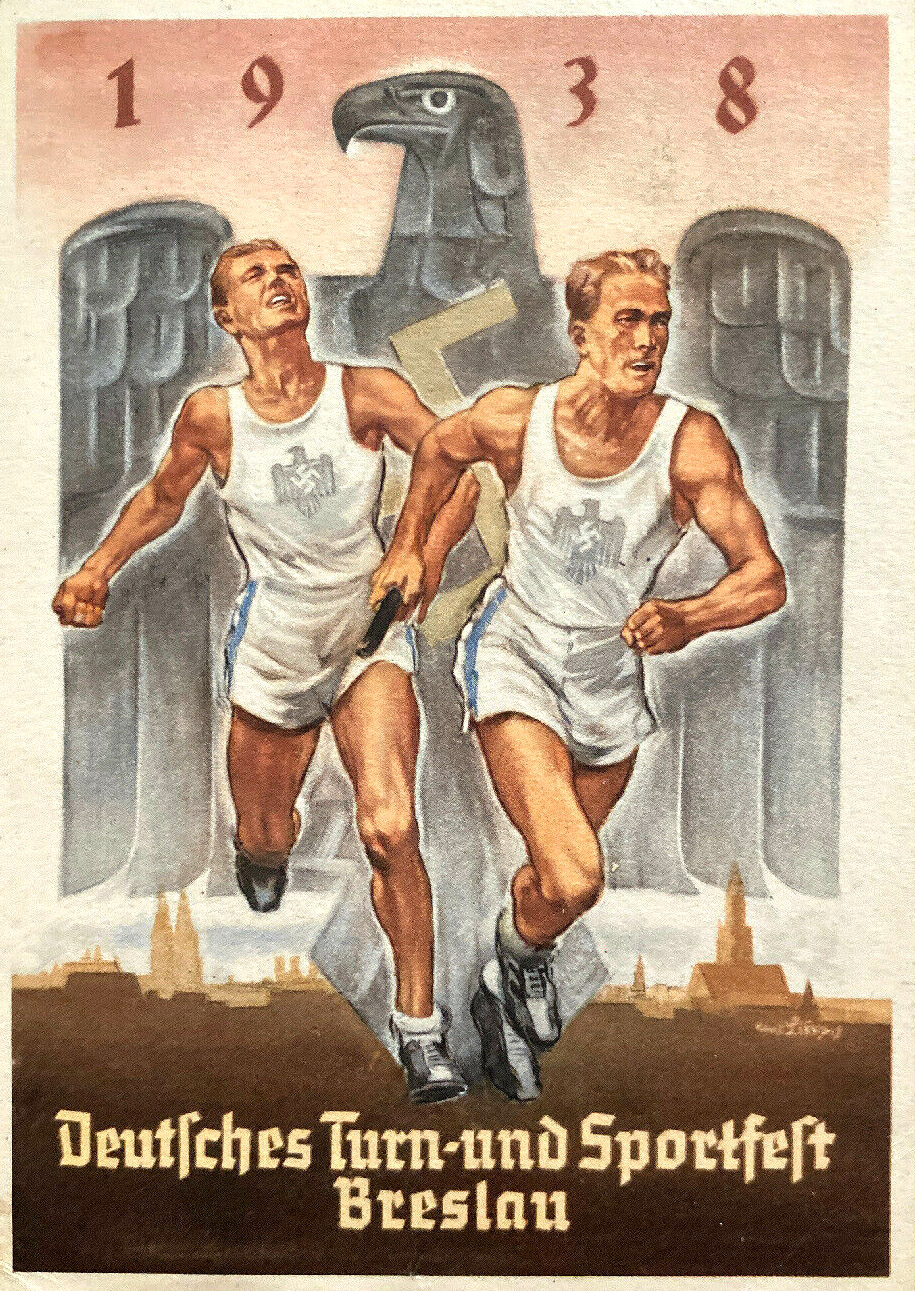


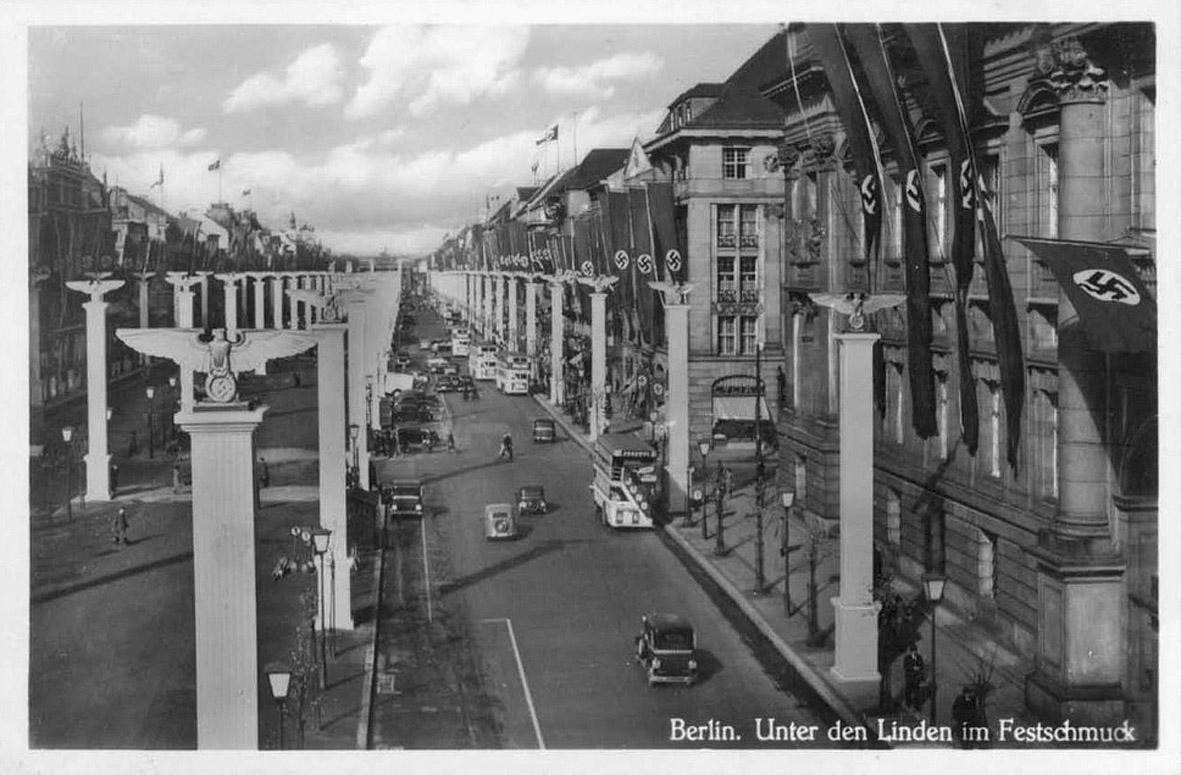
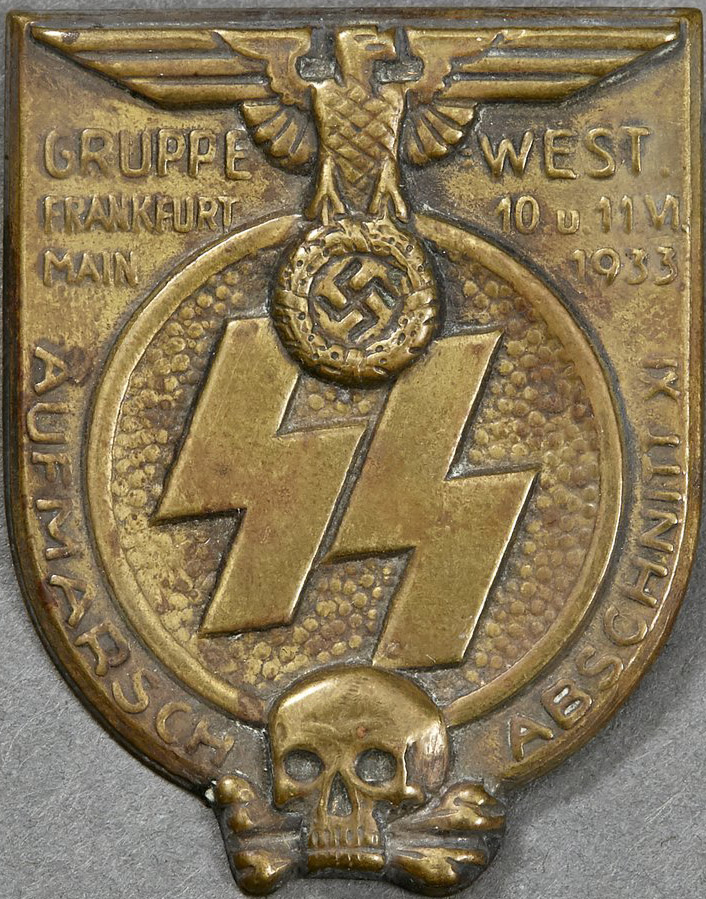
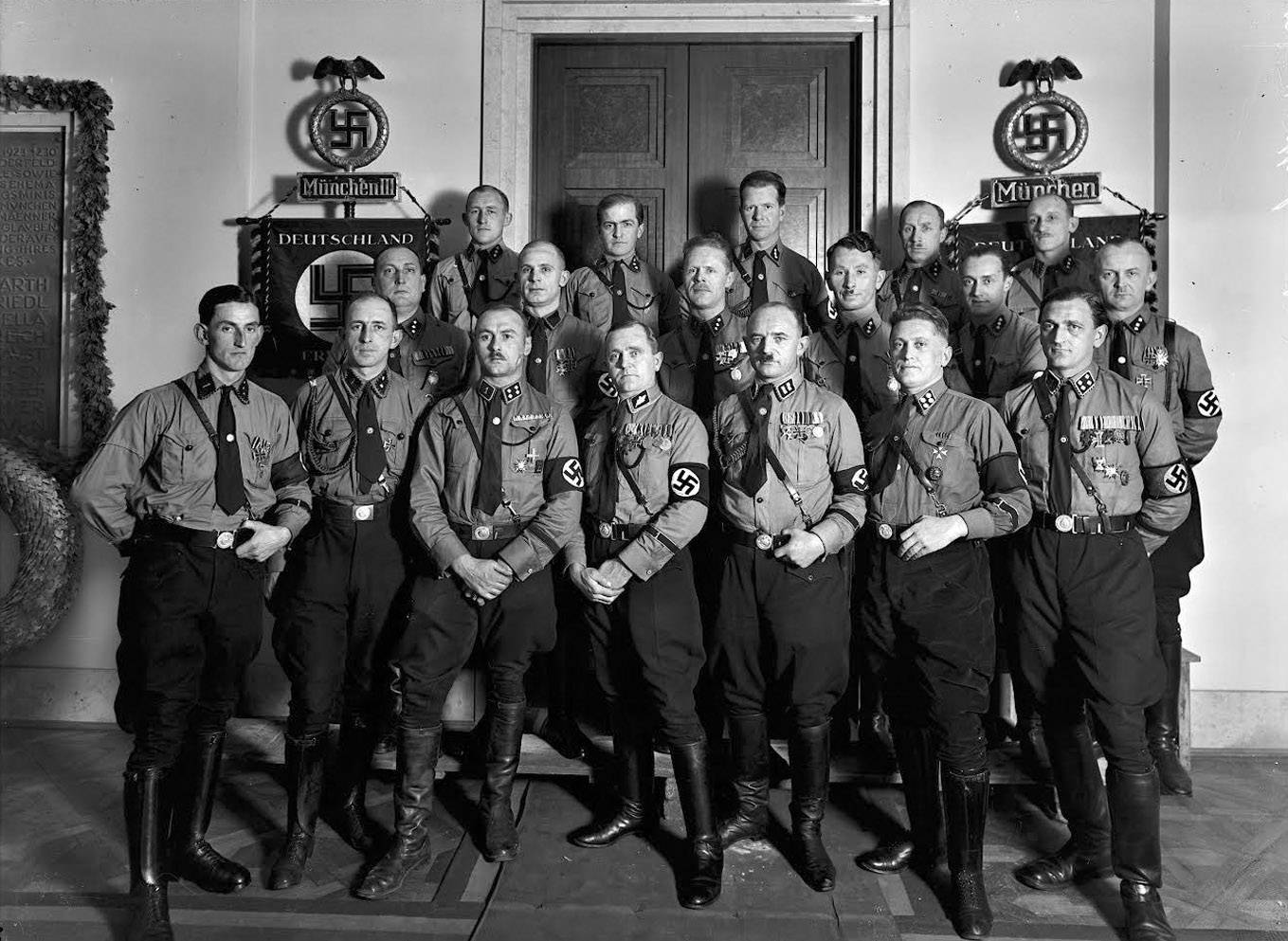
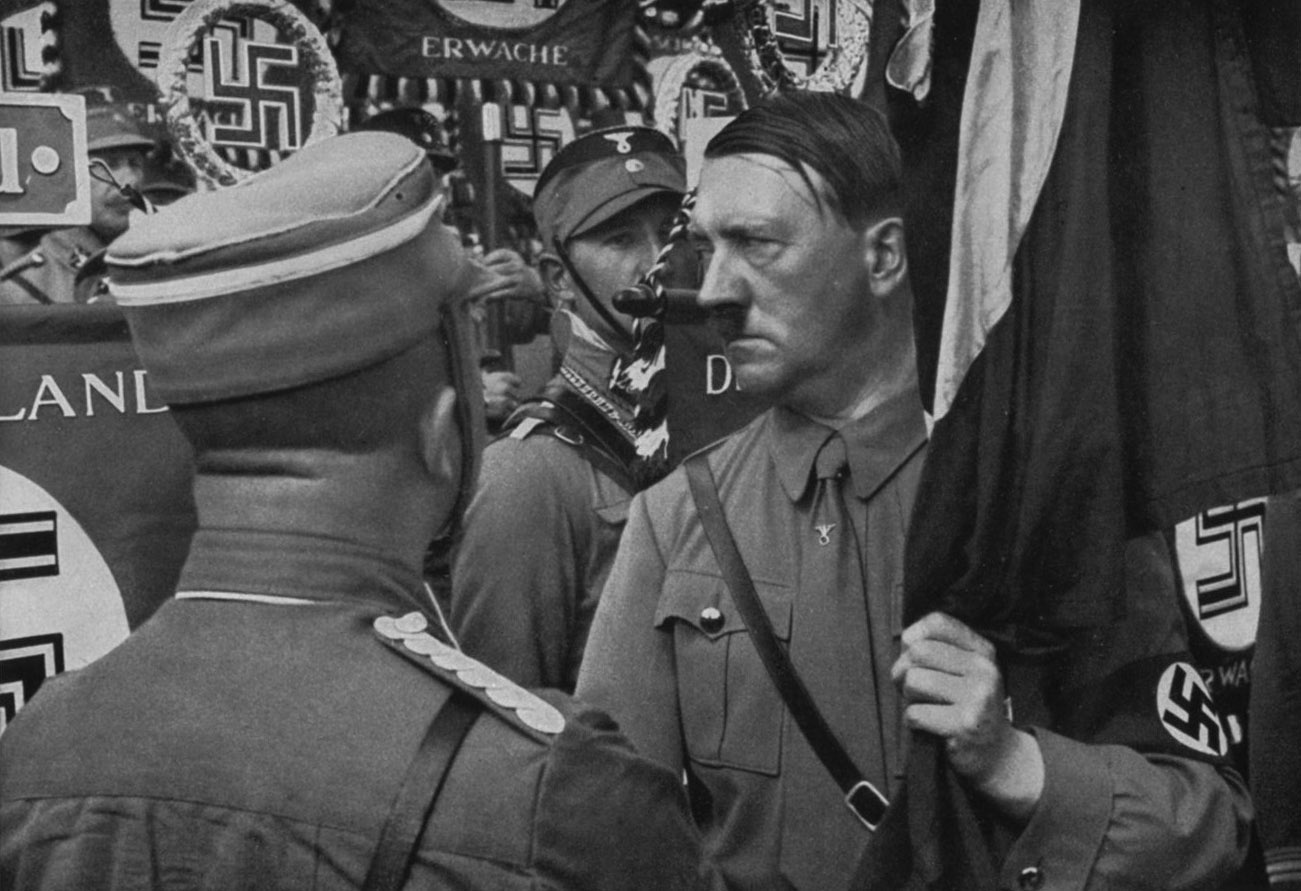
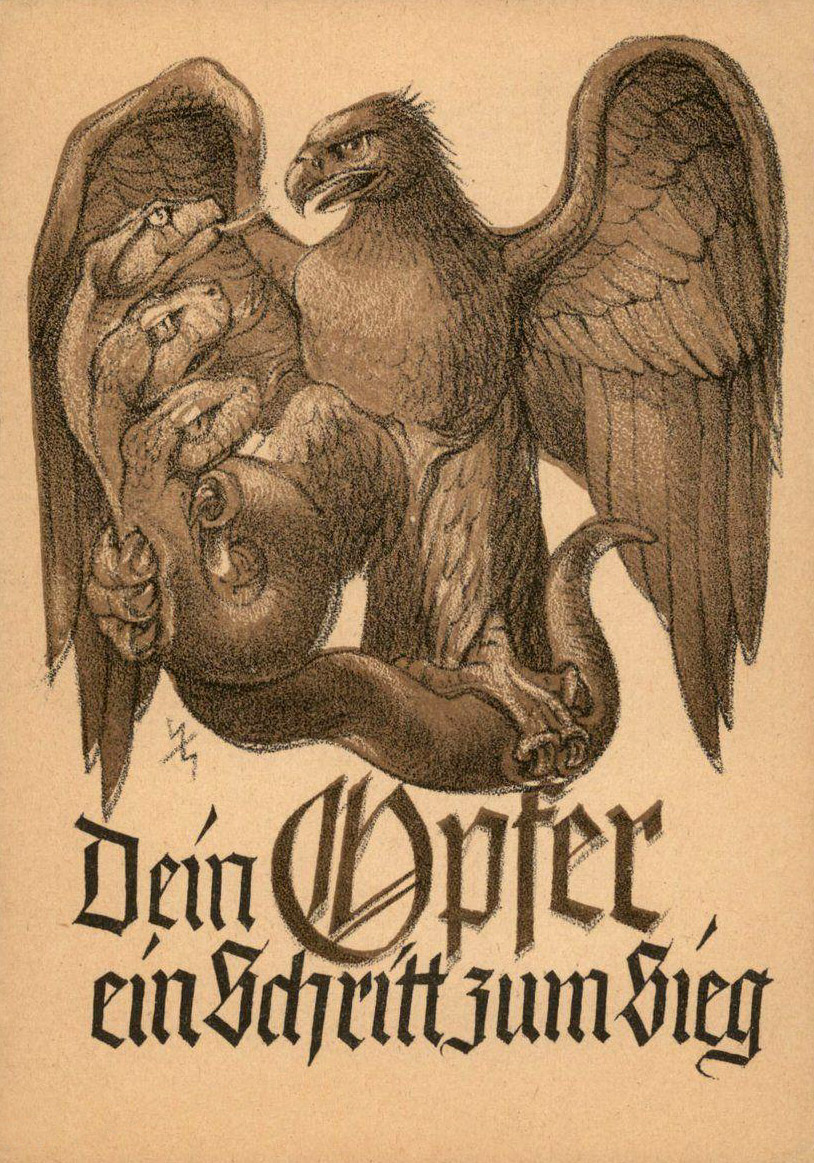
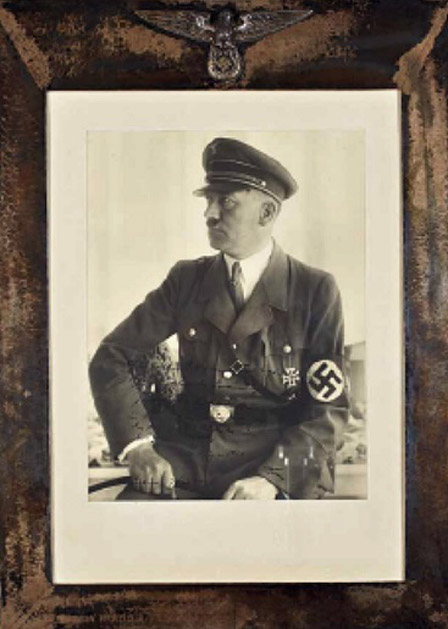
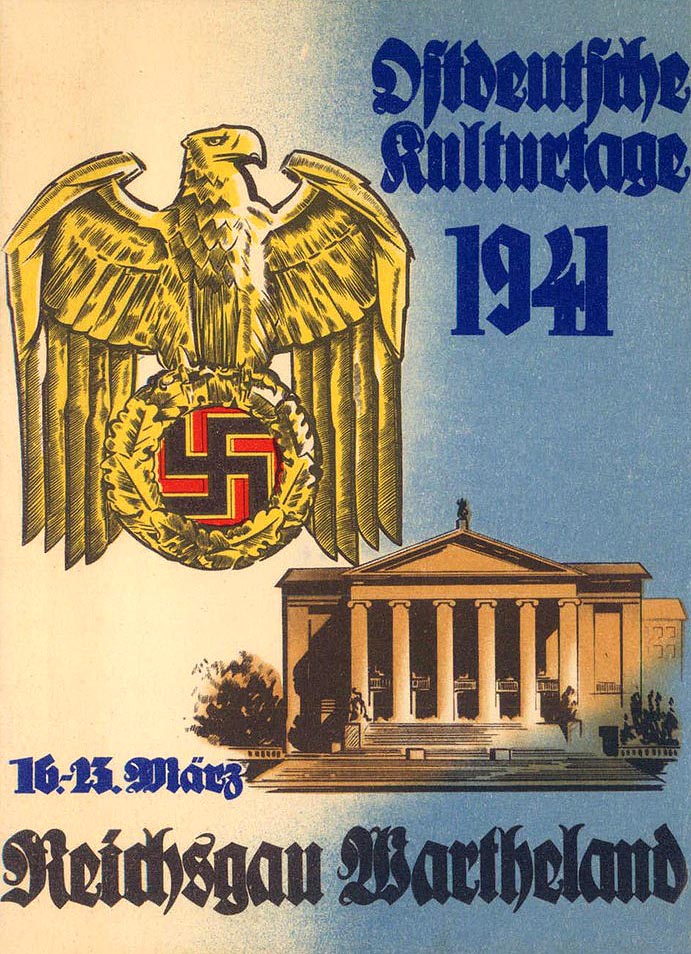

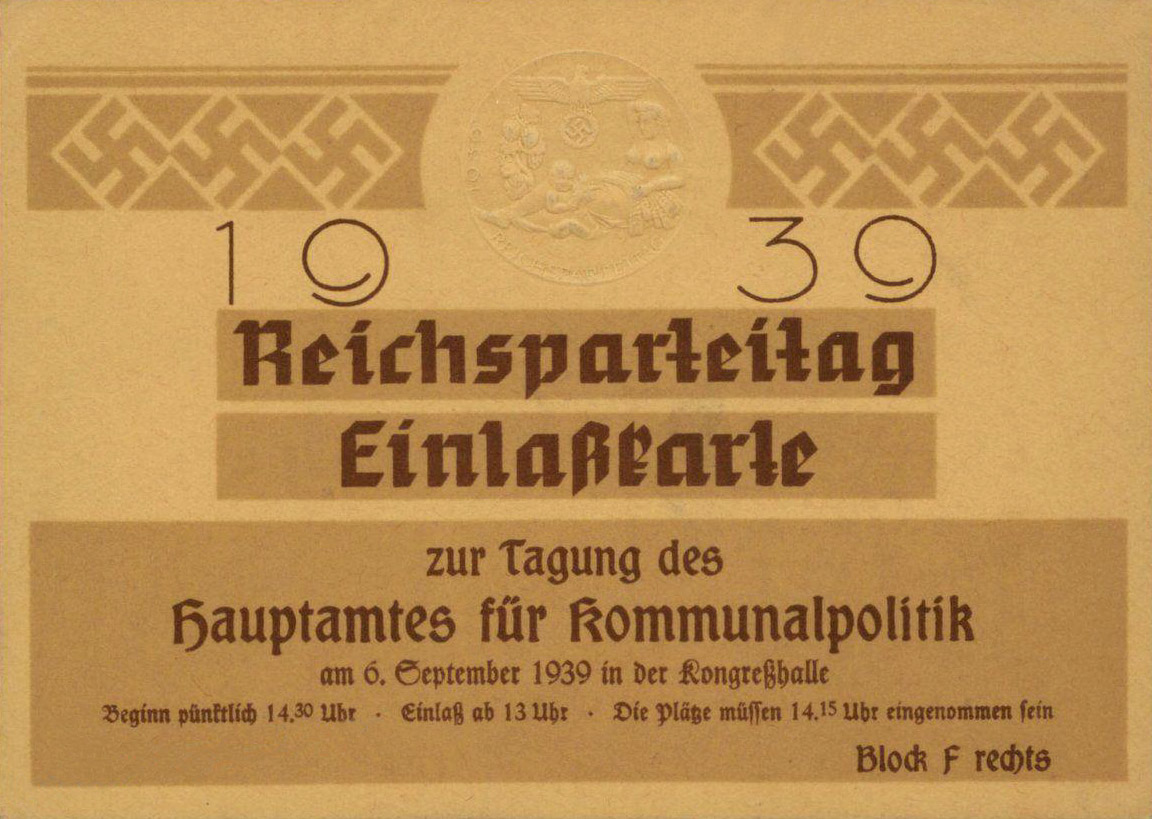

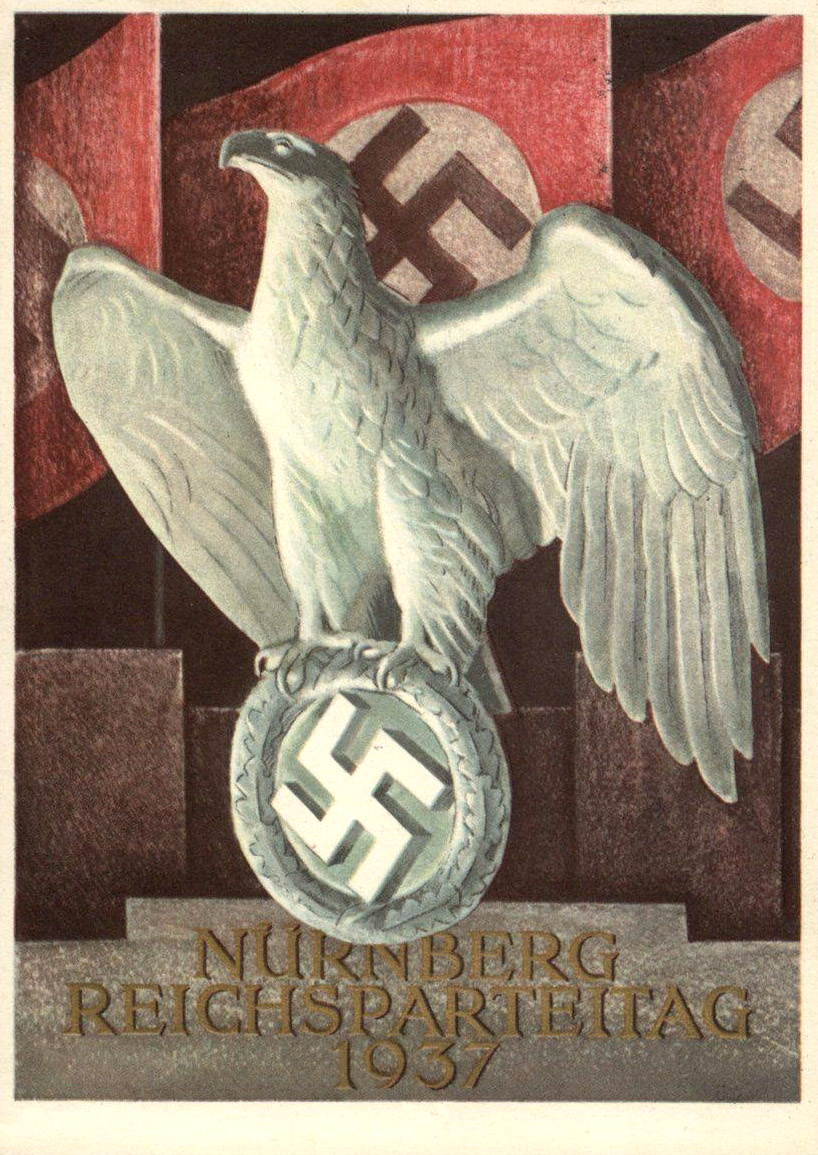
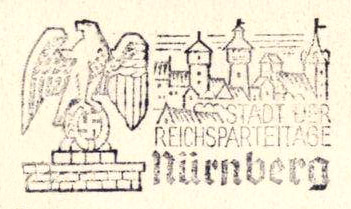

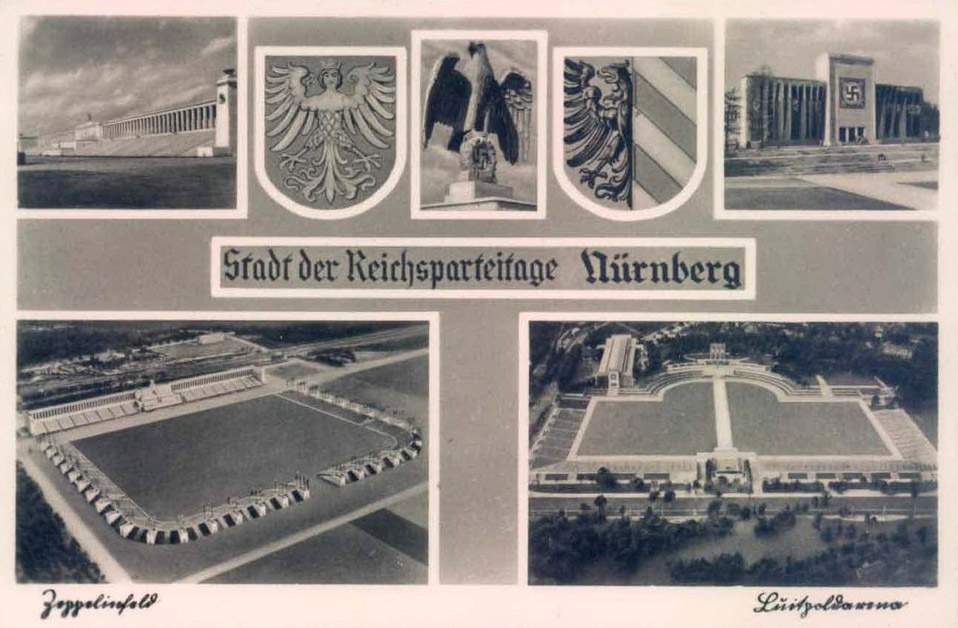
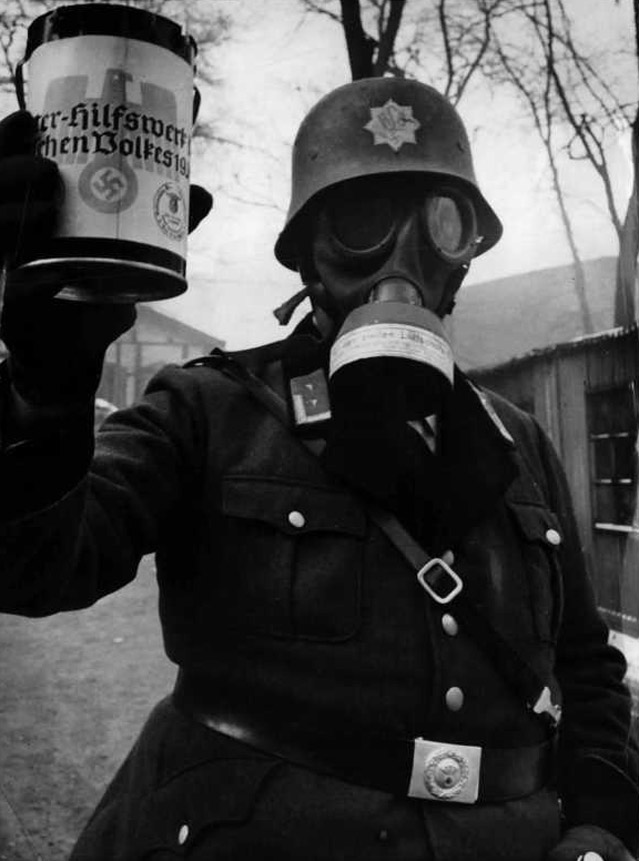
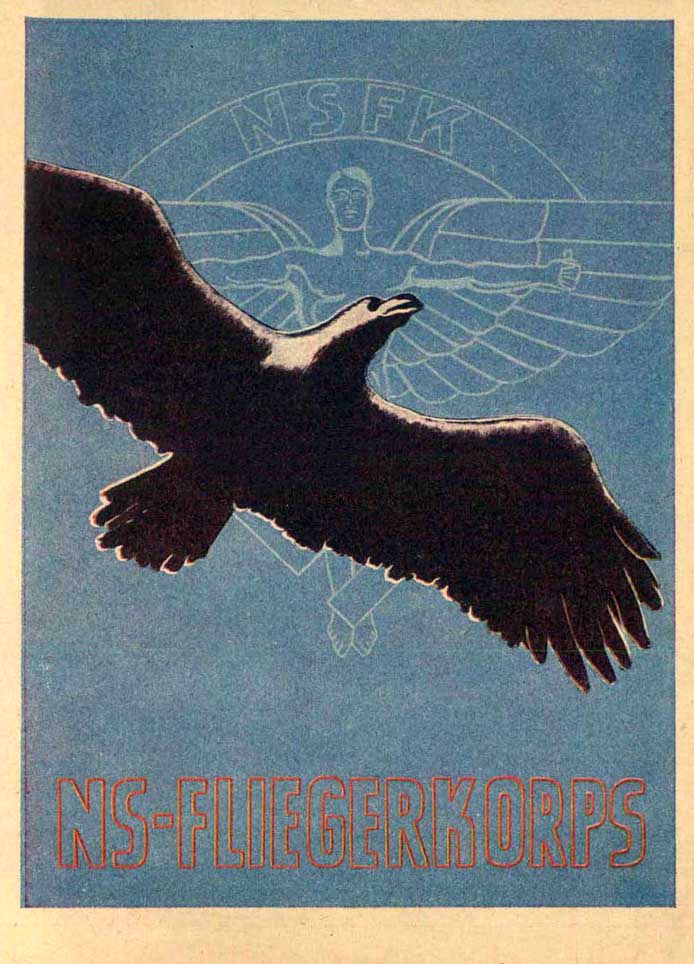
'Freiheit
dem Deutschen
Luftsport
Werdet Mitglied im
Deutschen Luftsport-Verband.]
to the German
Air Sports
Become a member of the
German Air Sports Association)
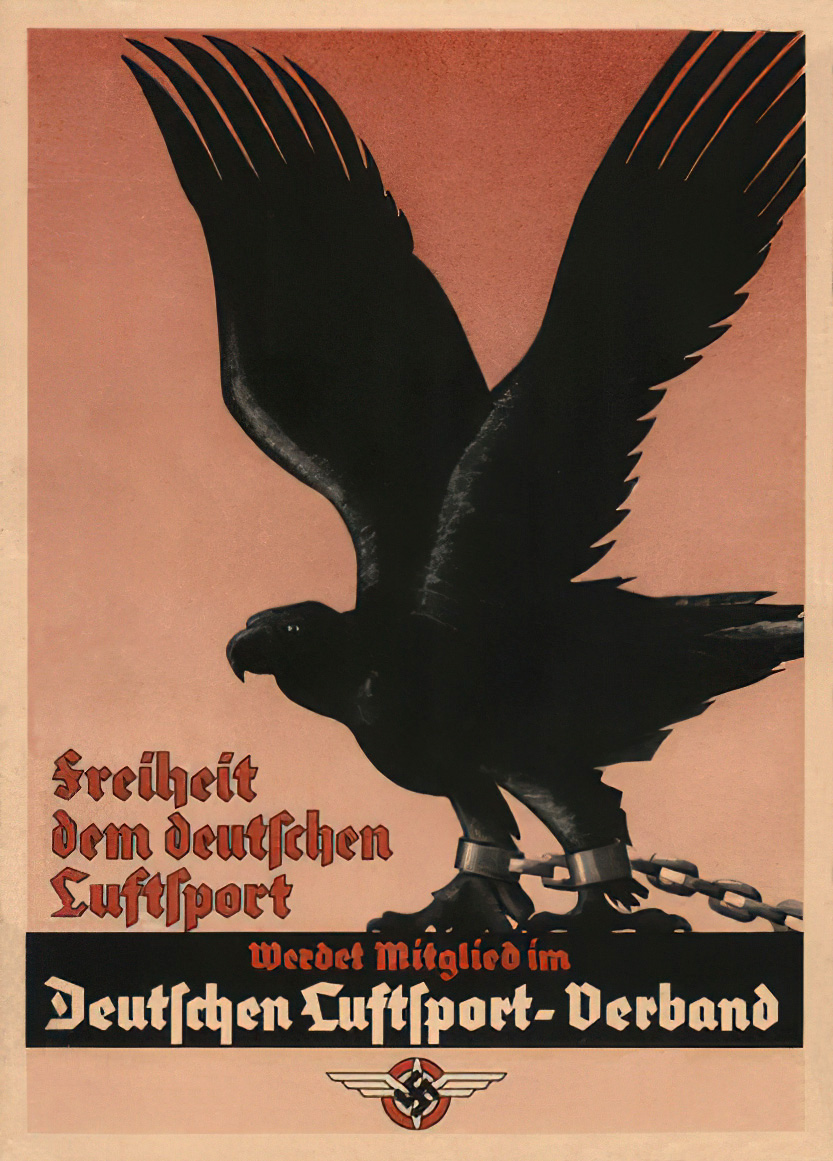
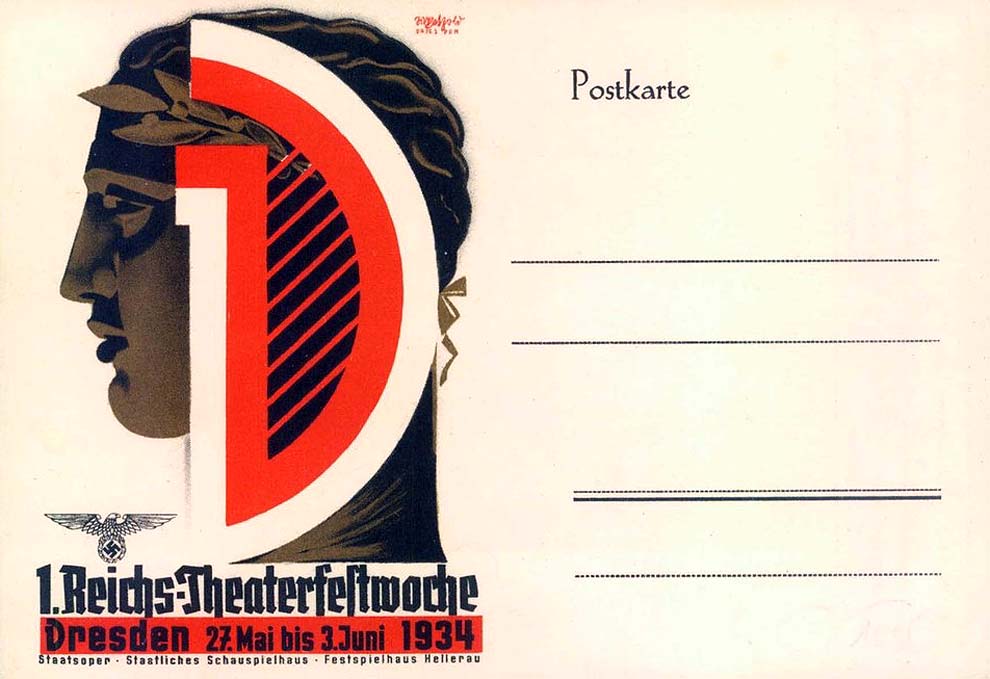
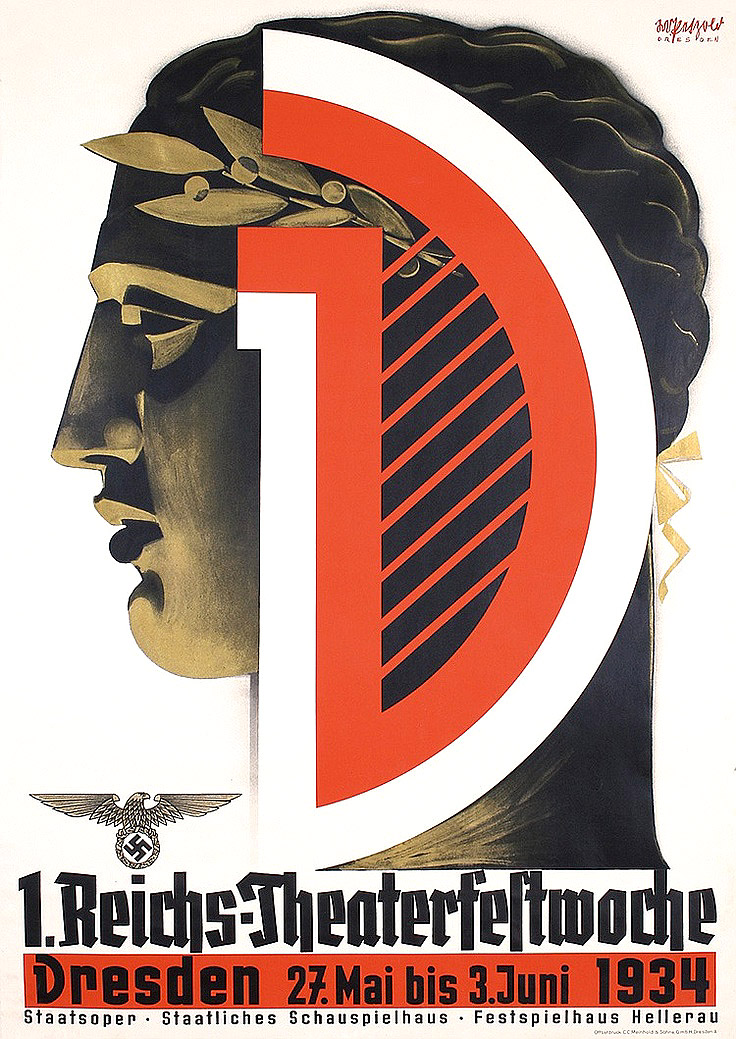
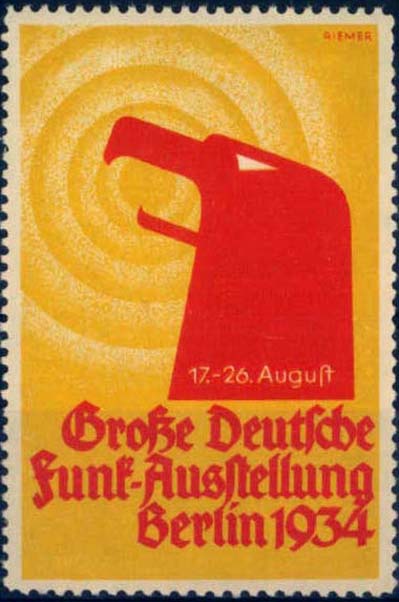
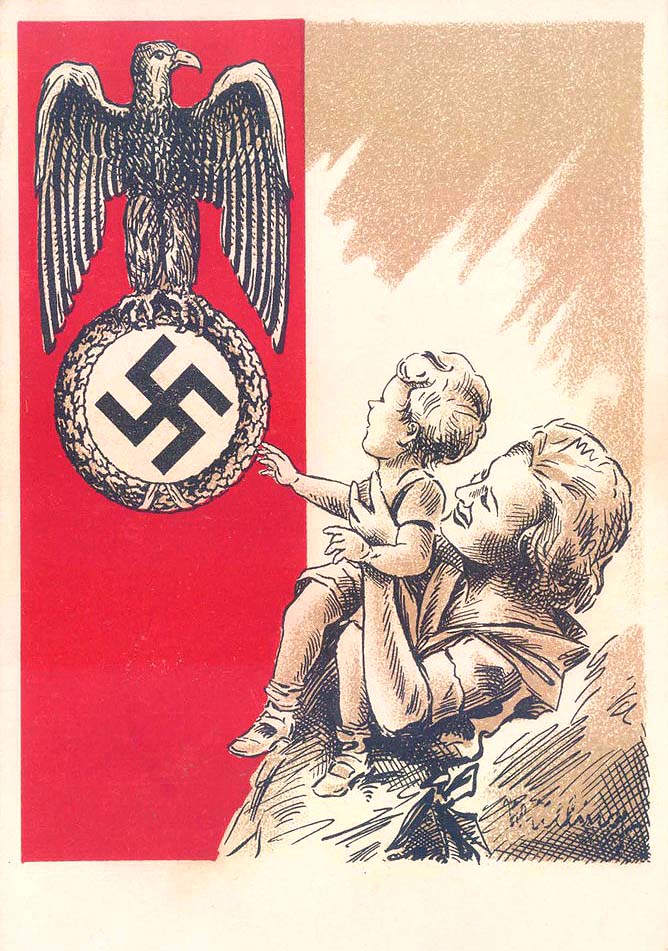
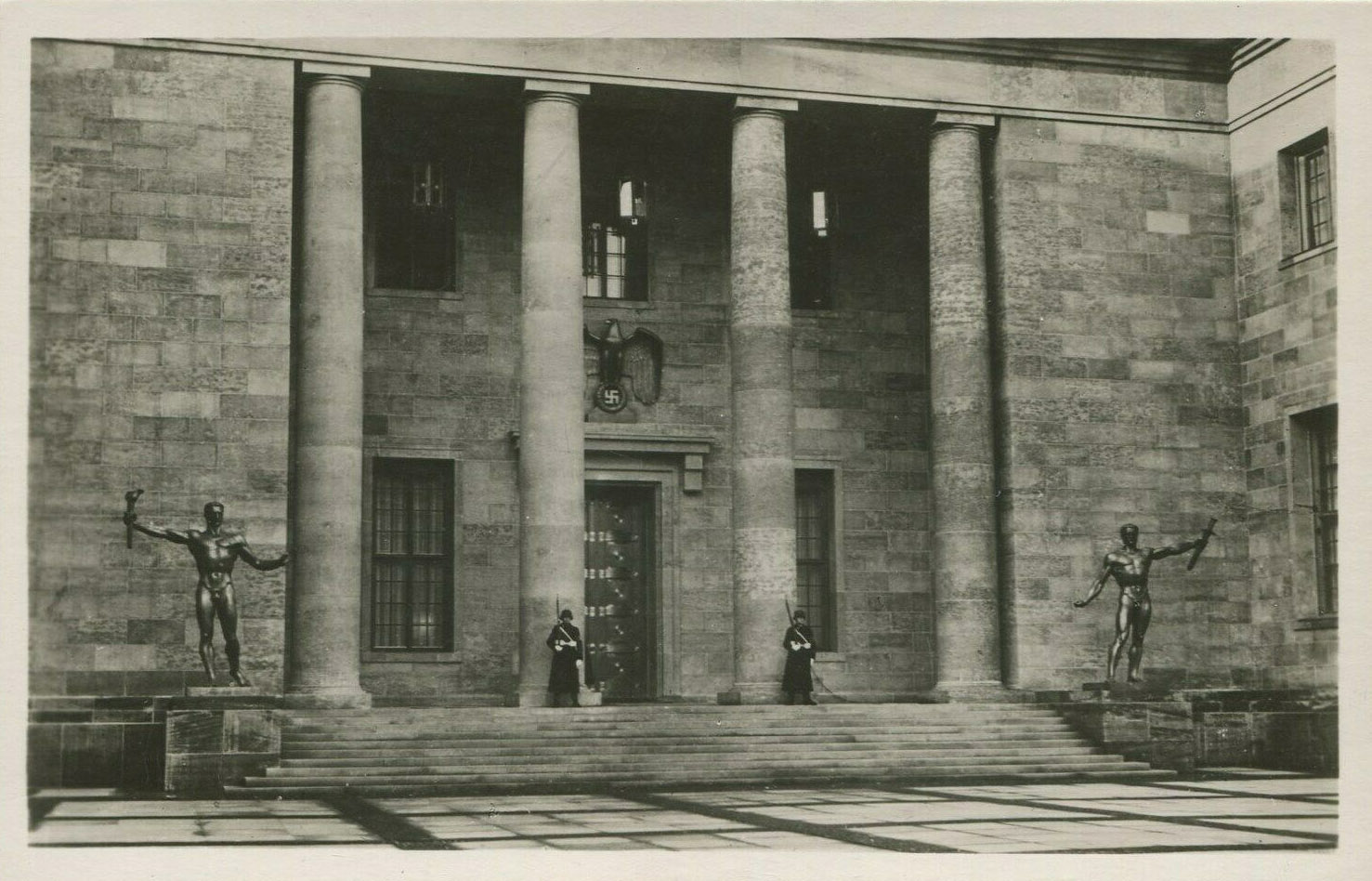
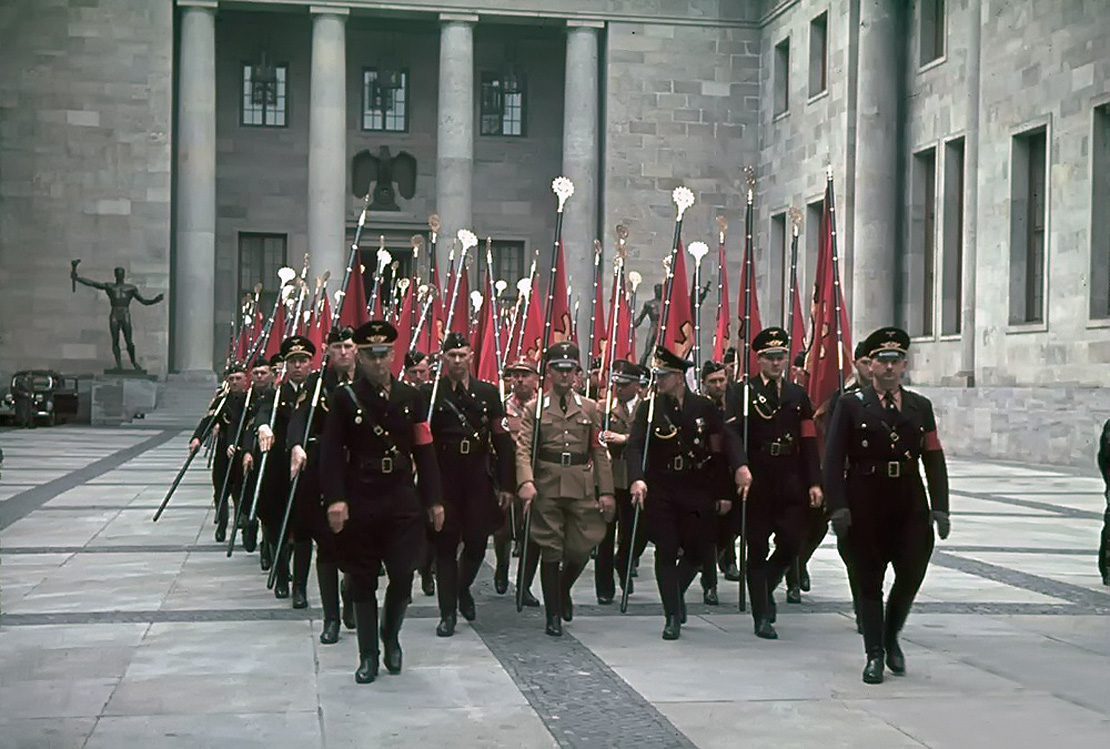
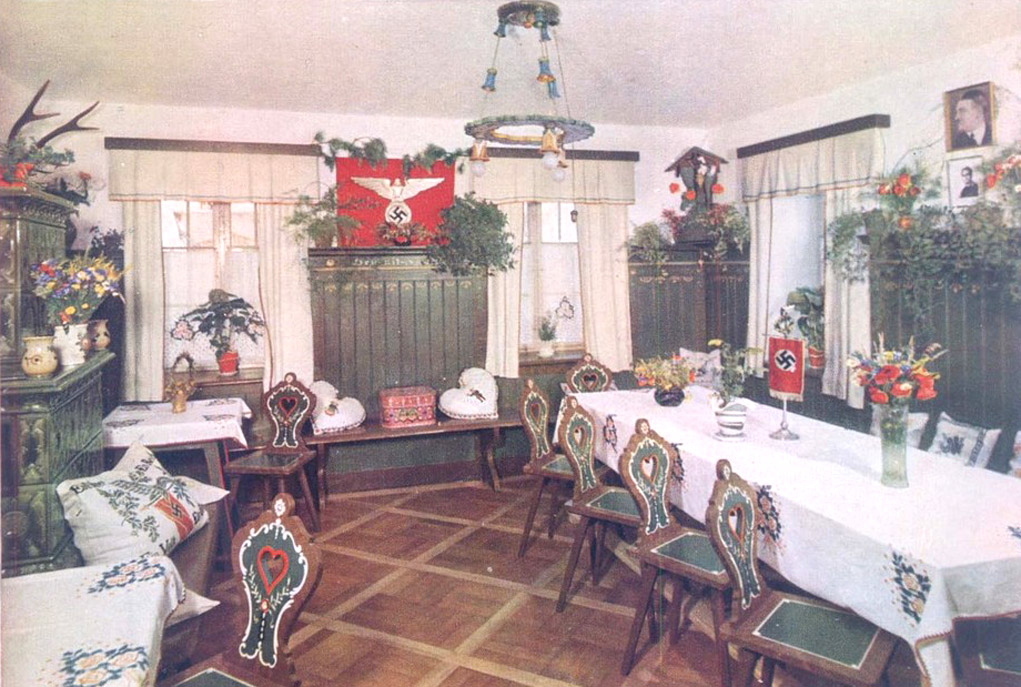
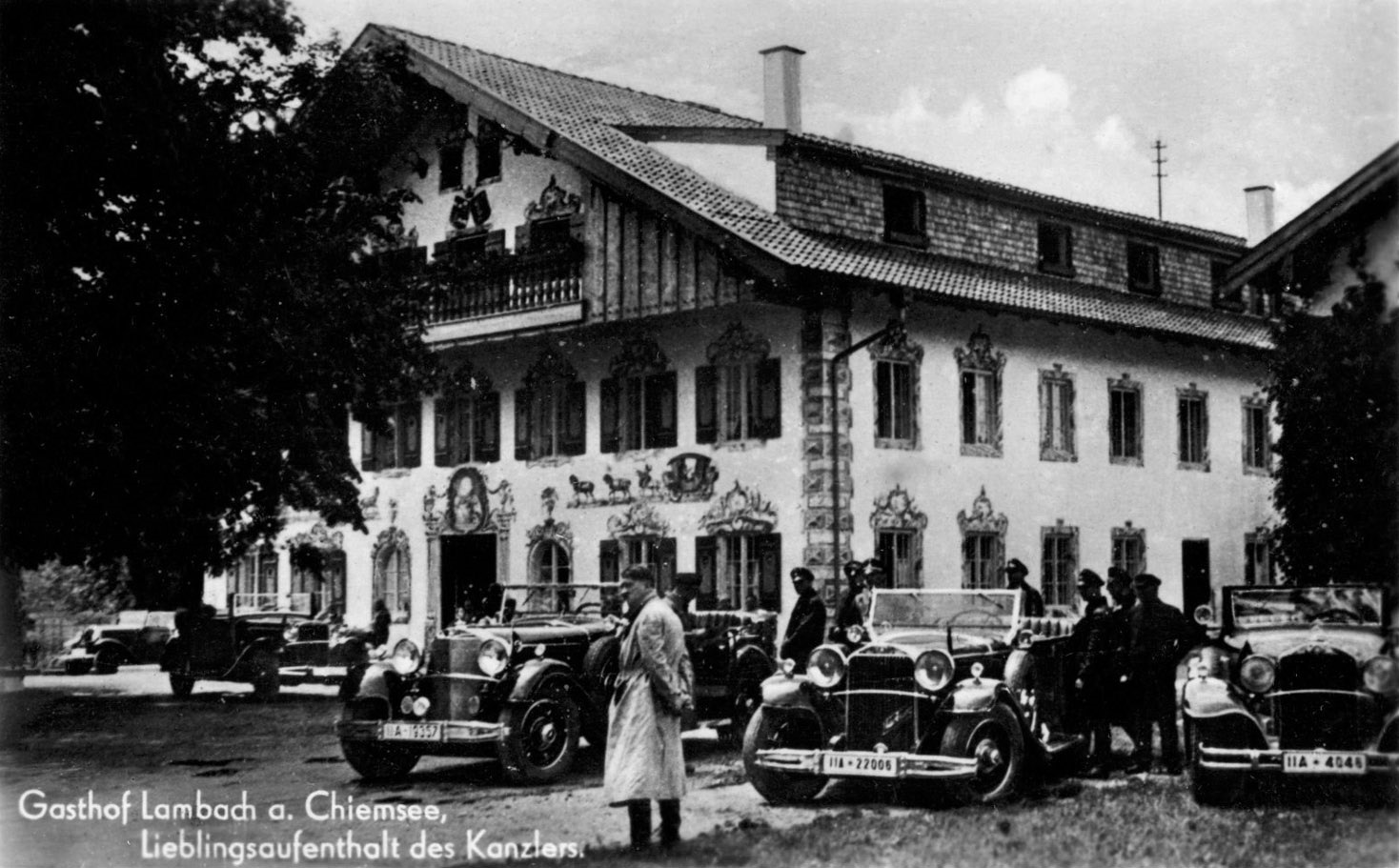
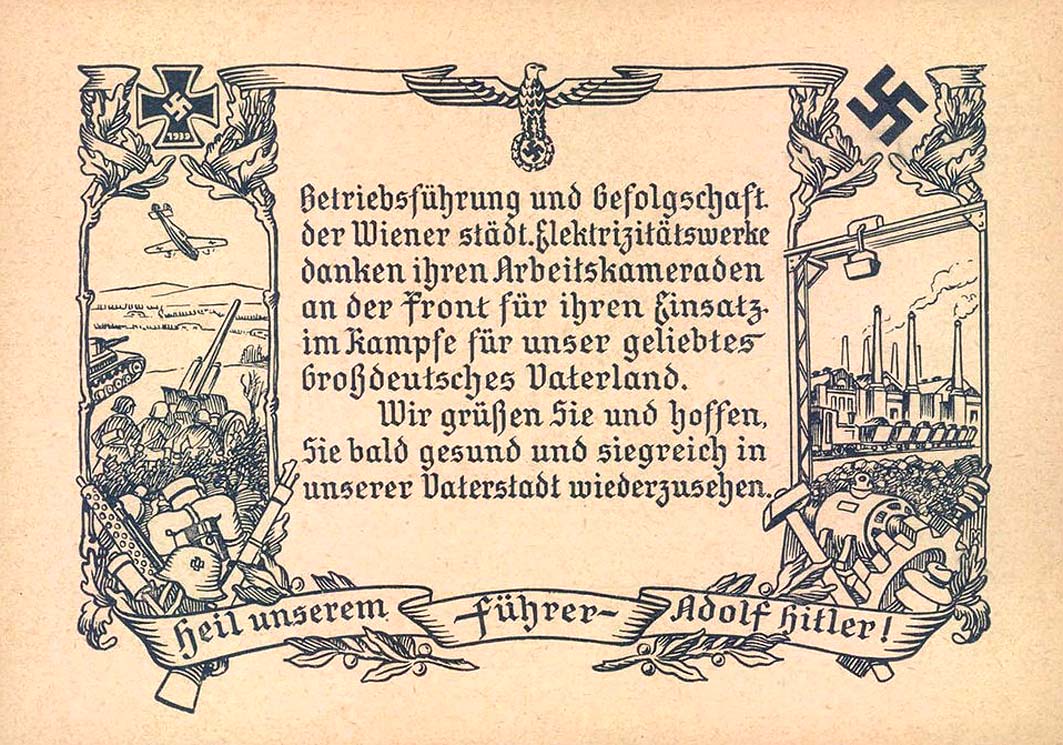
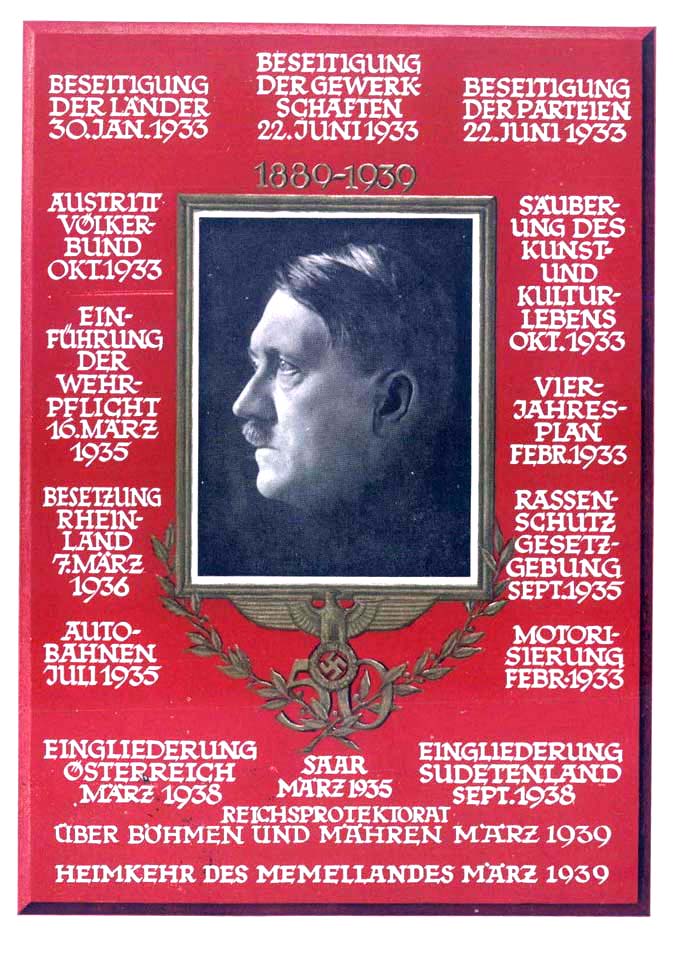
-Léon Degrelle speaking of his beloved dog 'Dogo'.
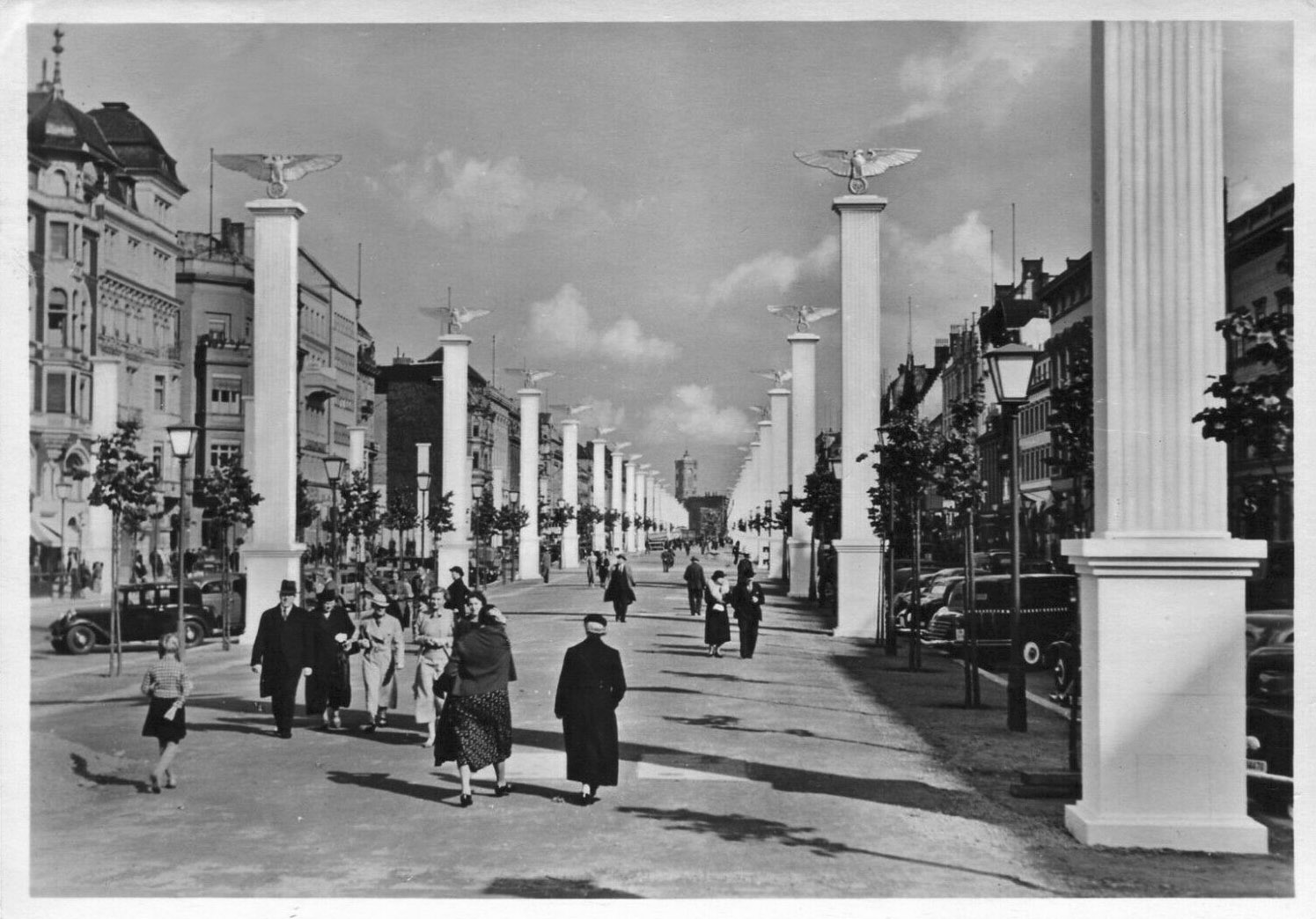
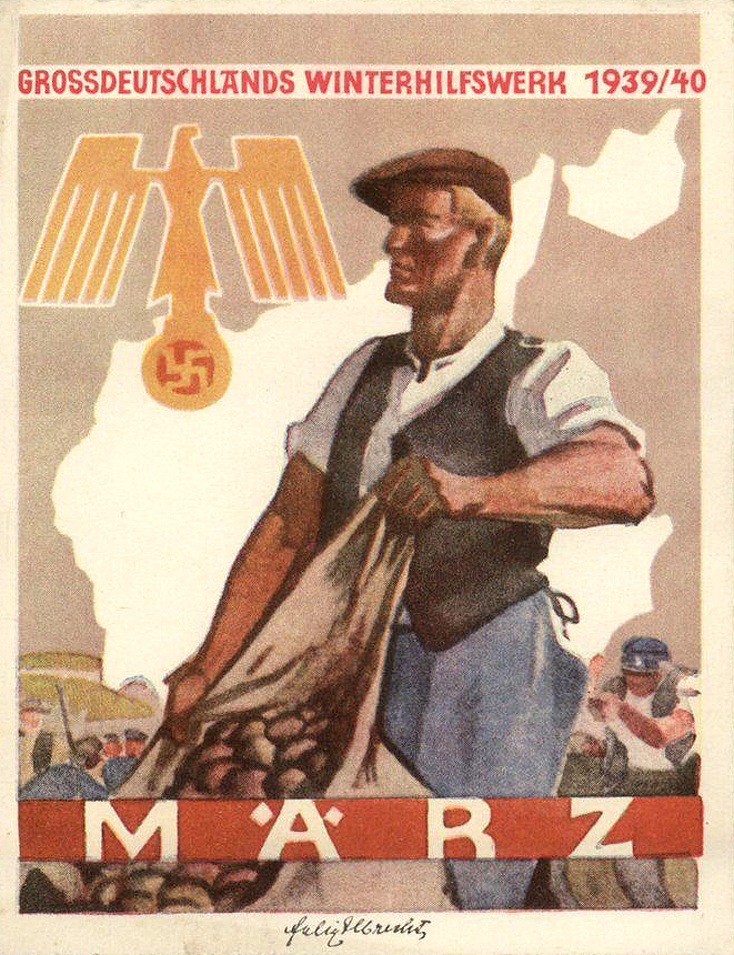
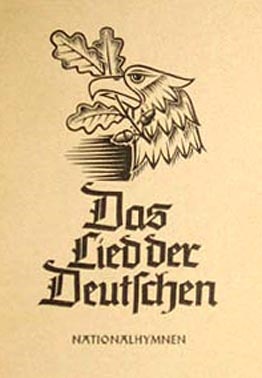
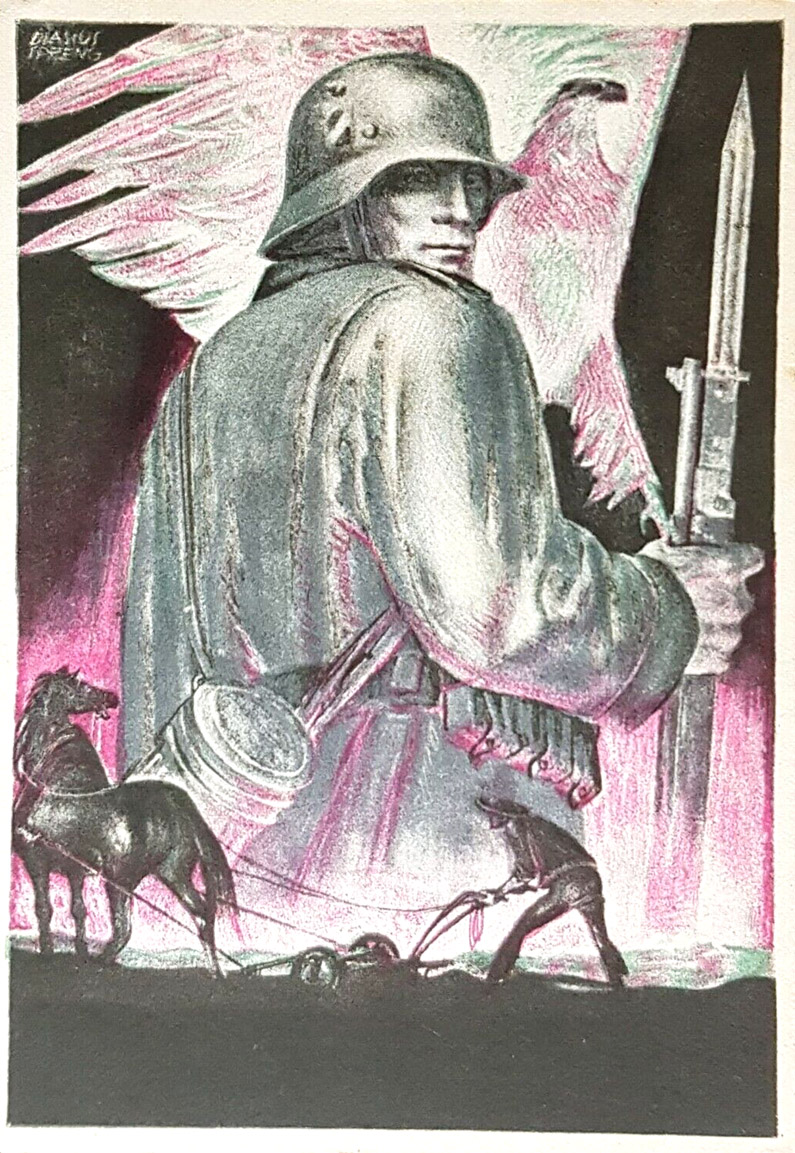
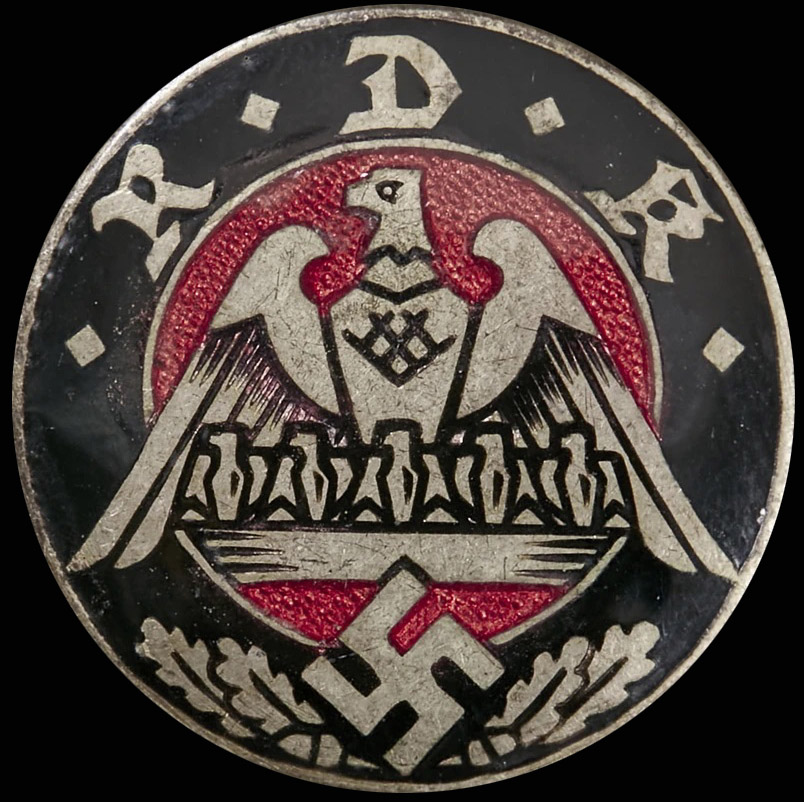
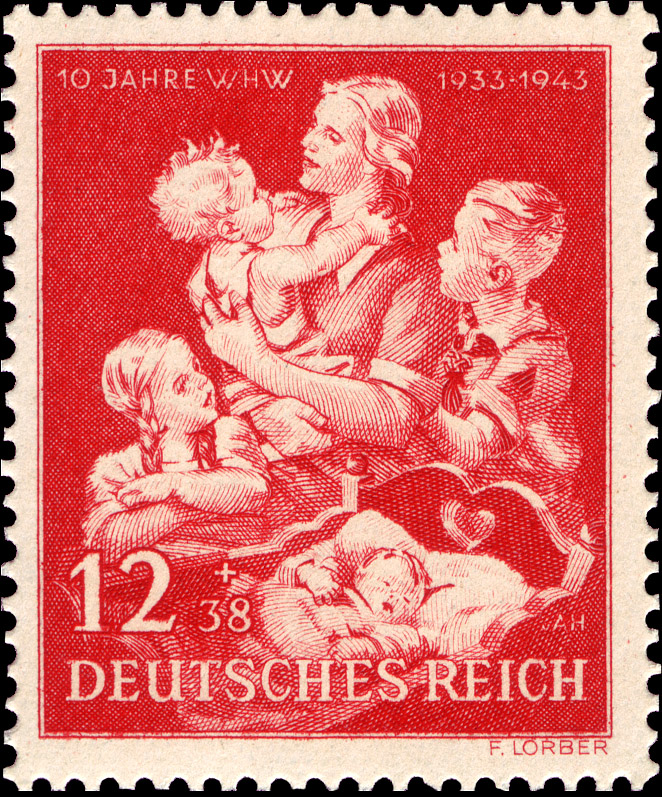
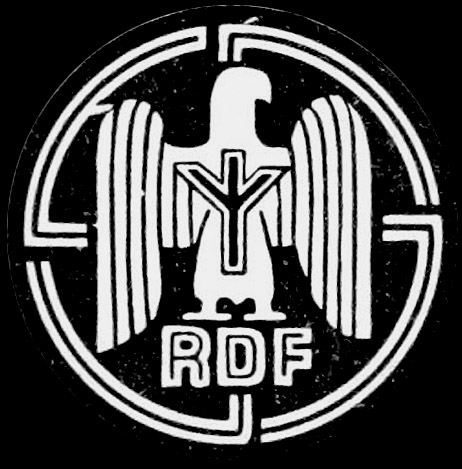
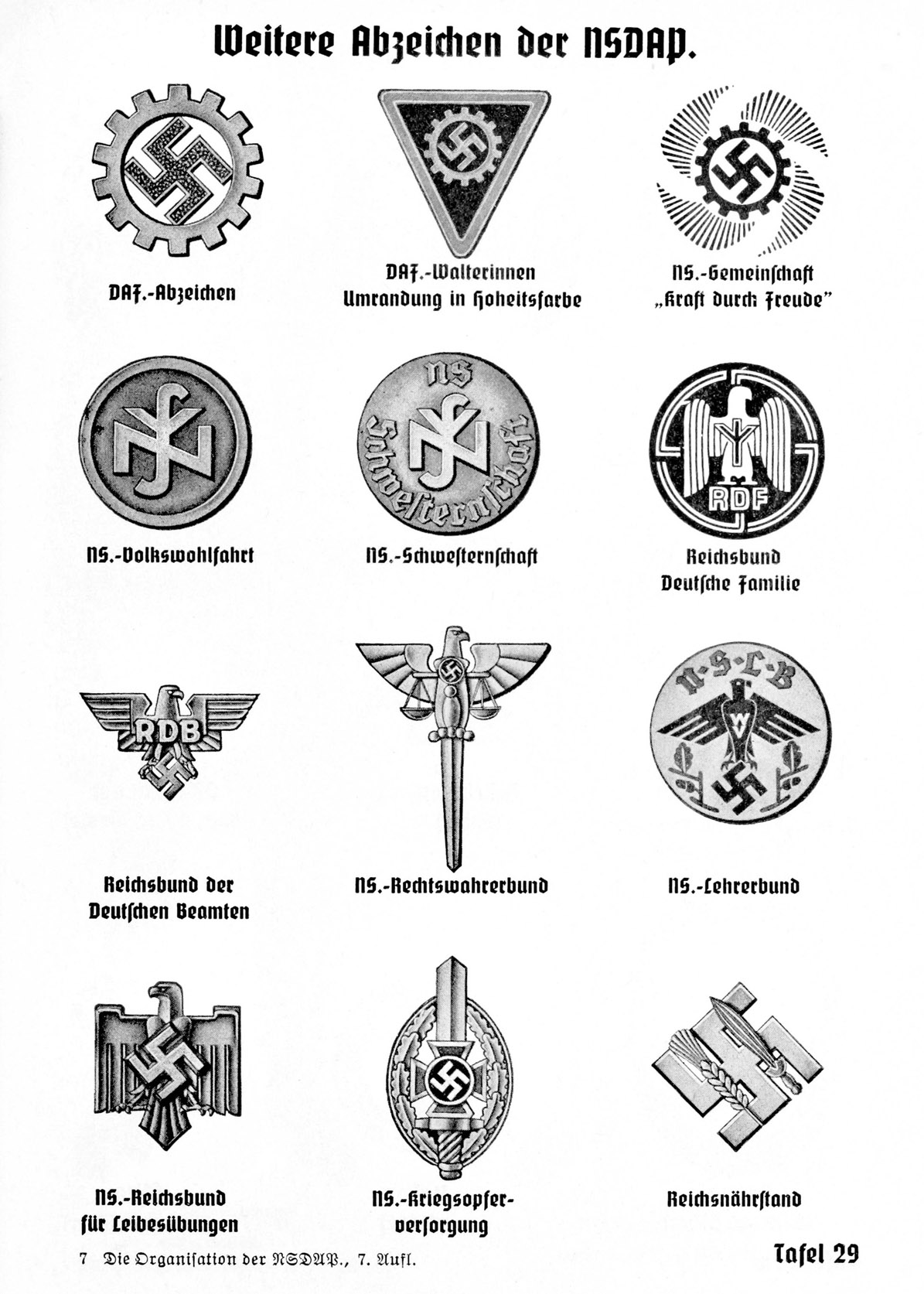
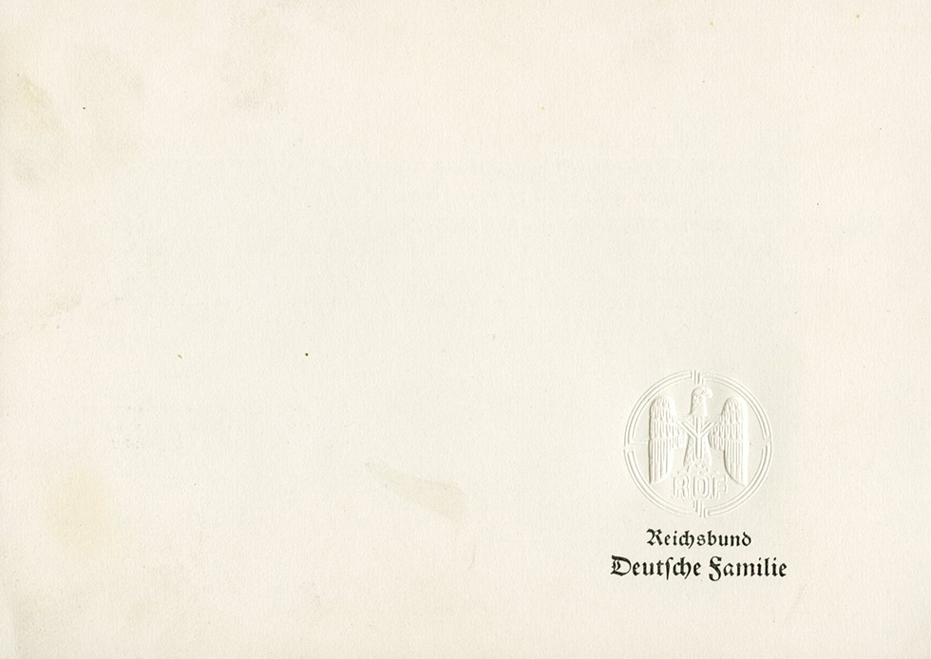
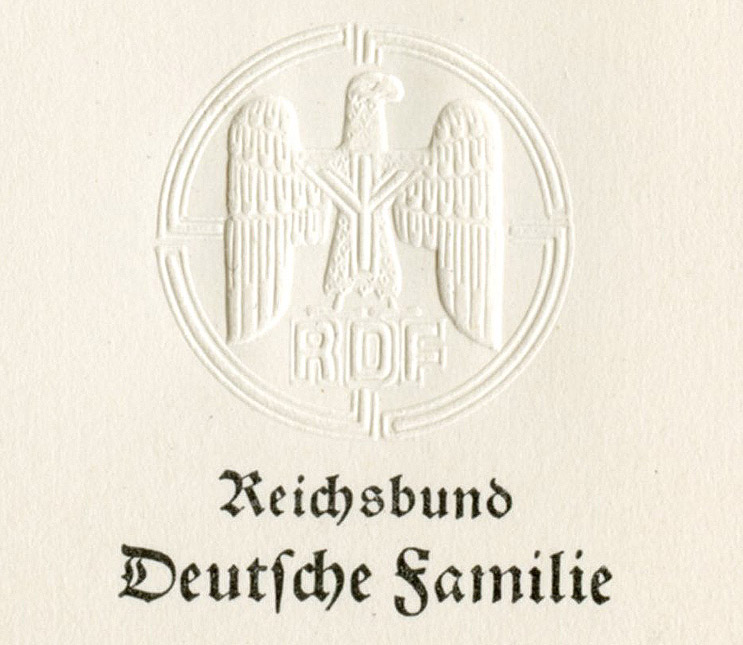
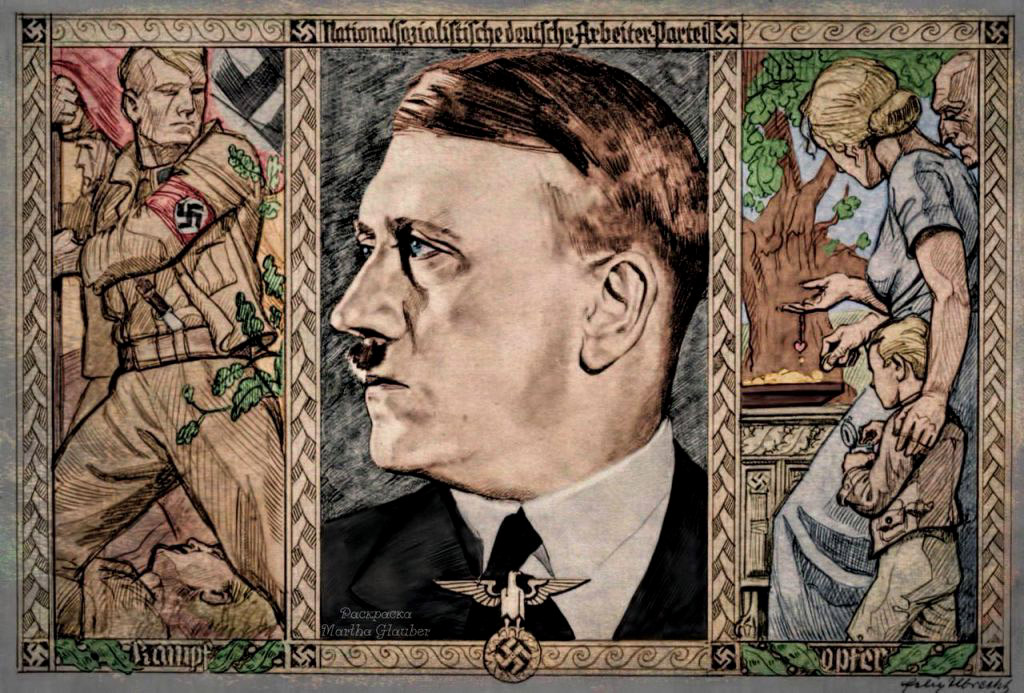

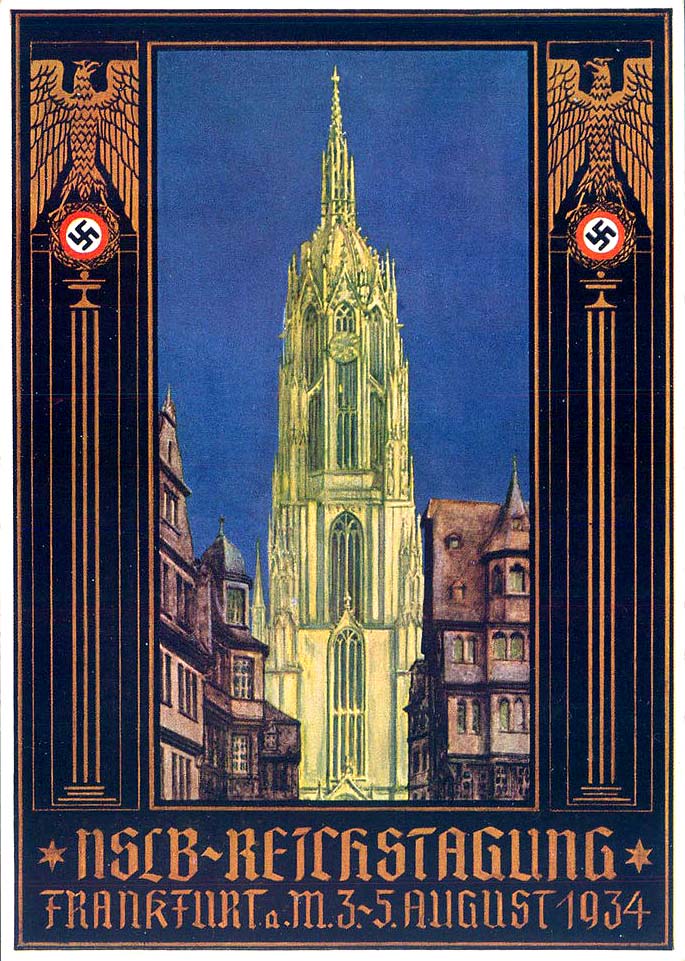

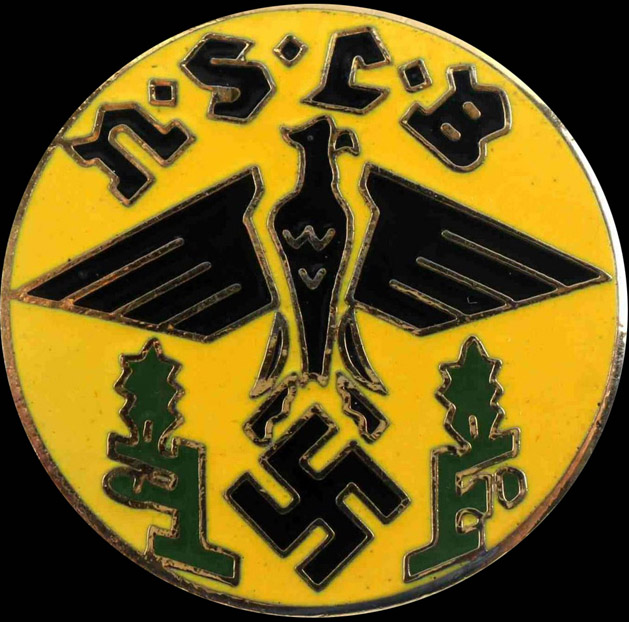
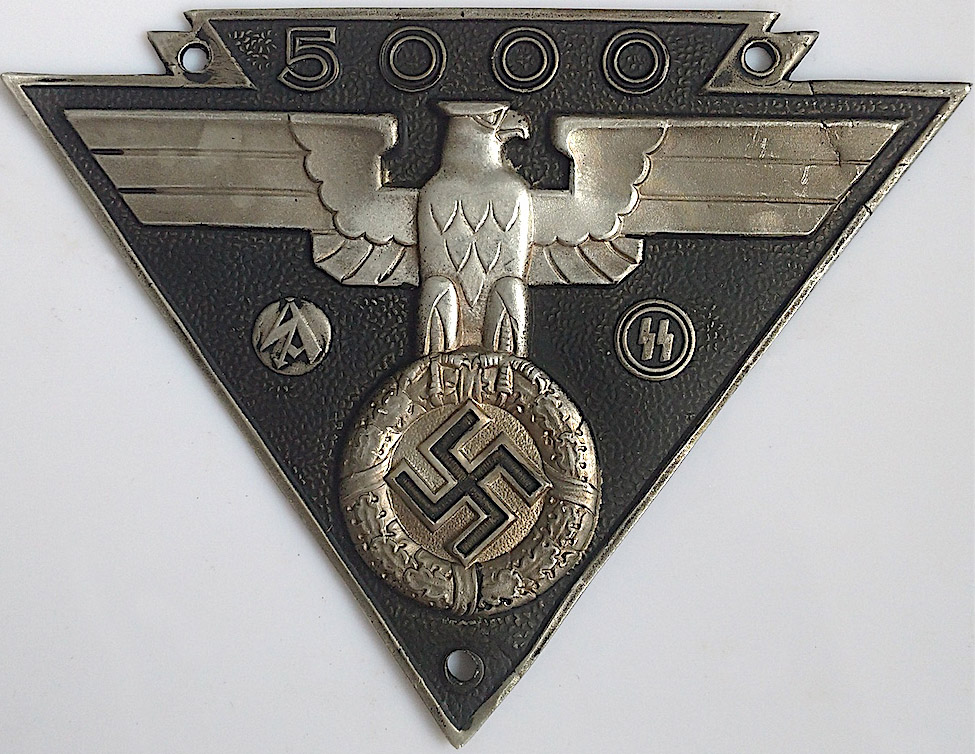
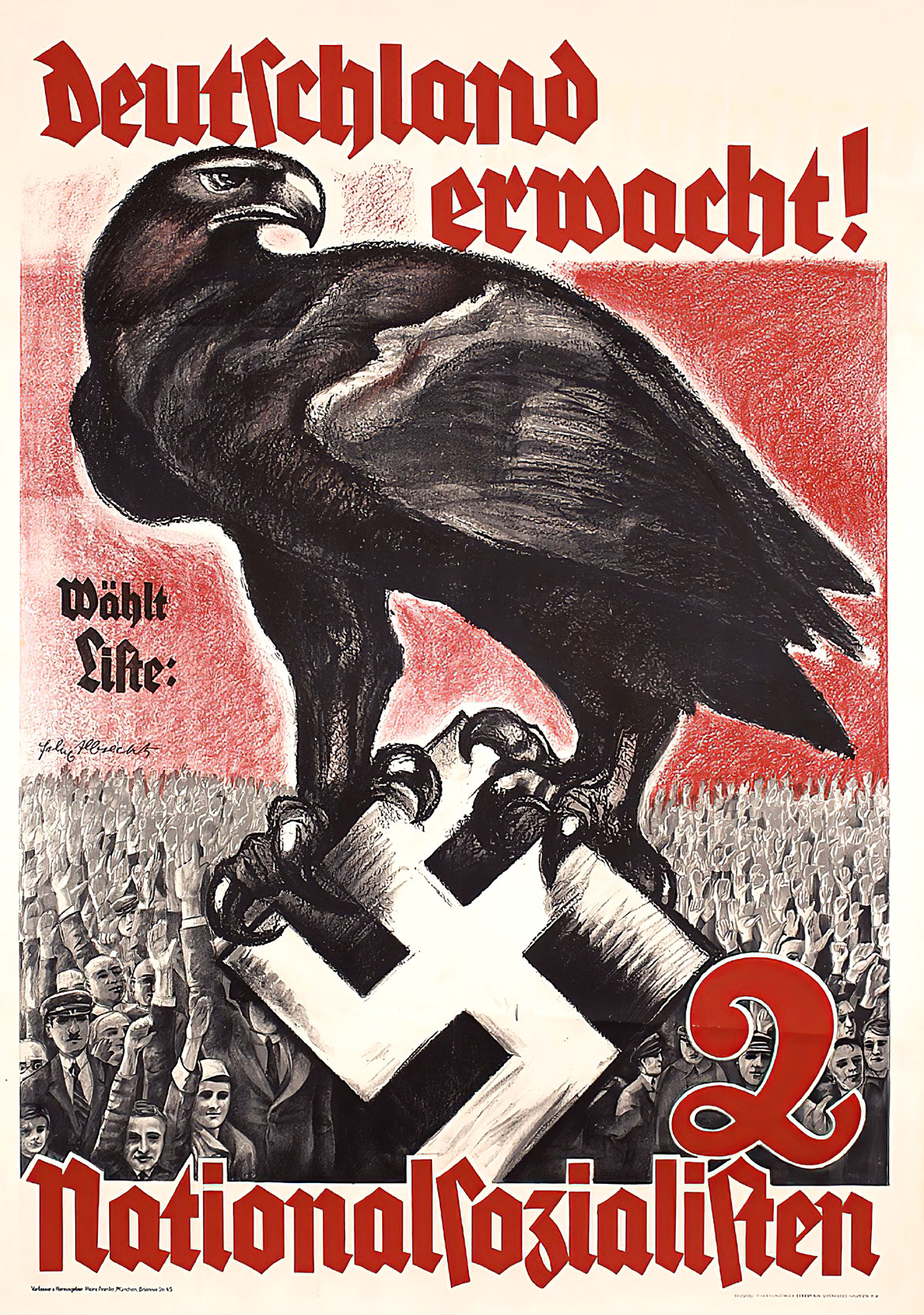
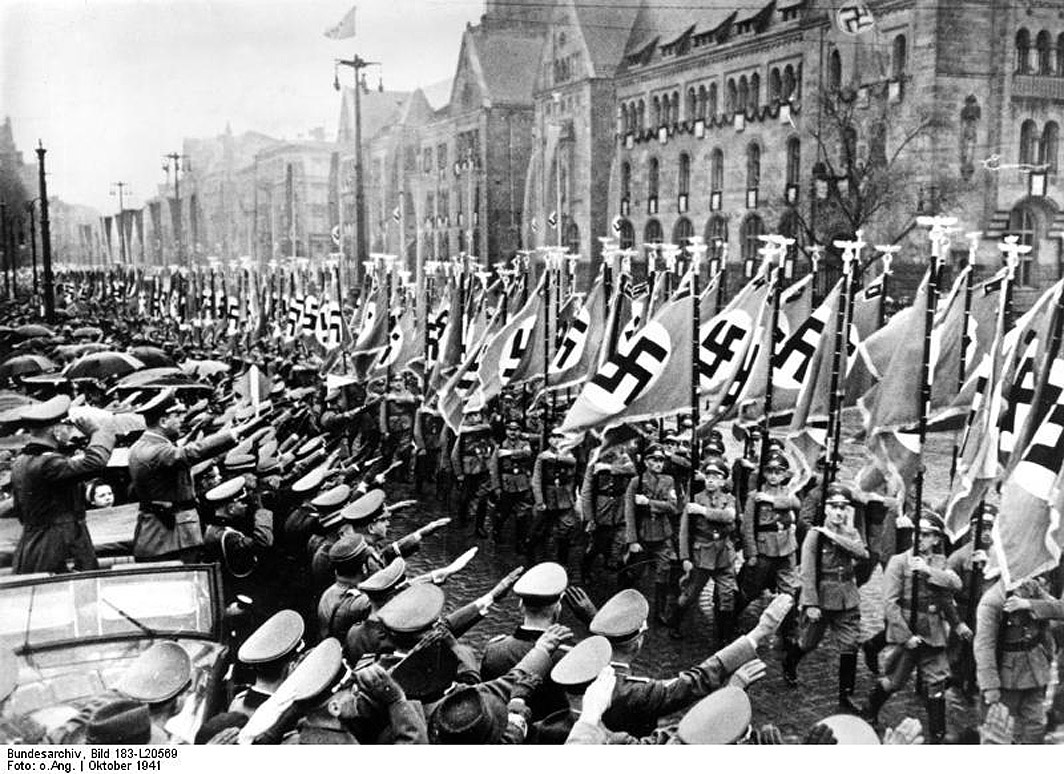
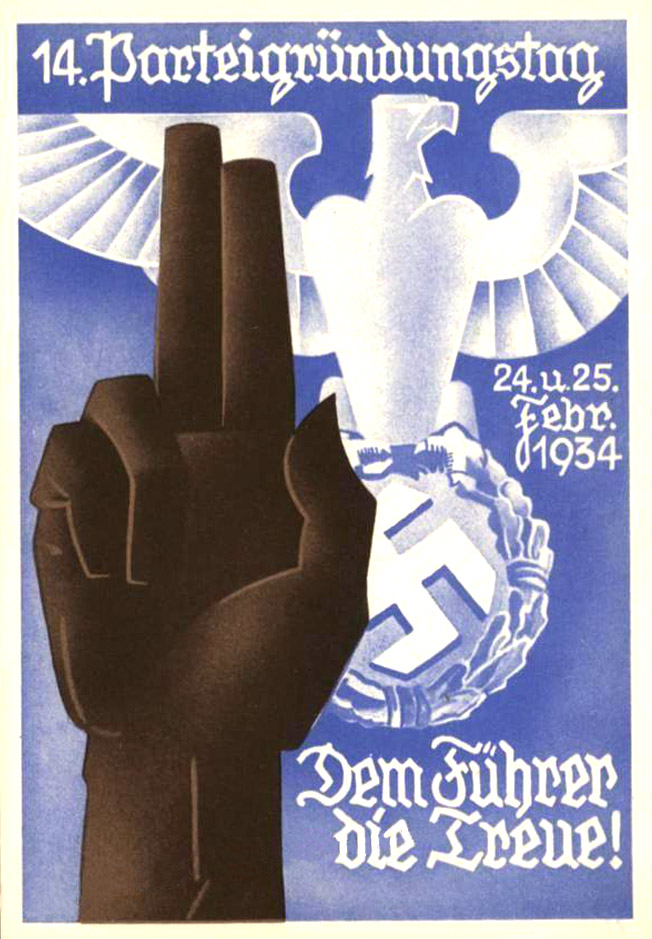
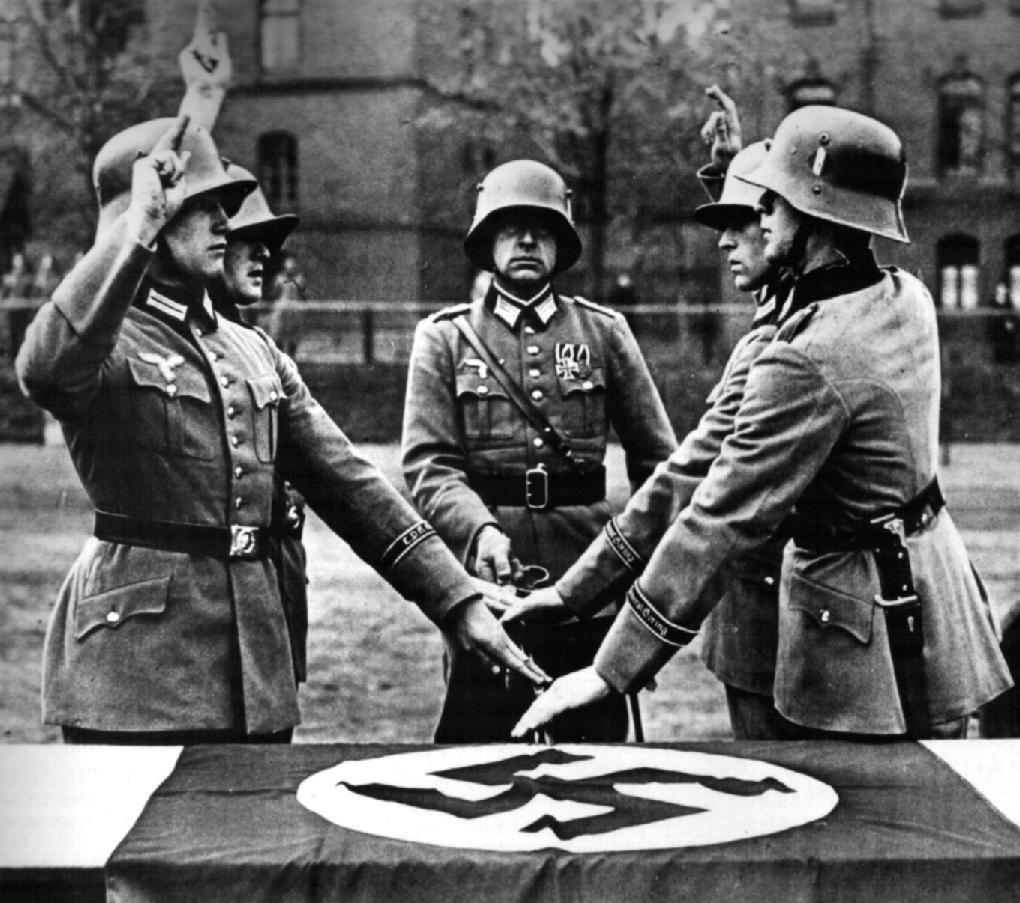
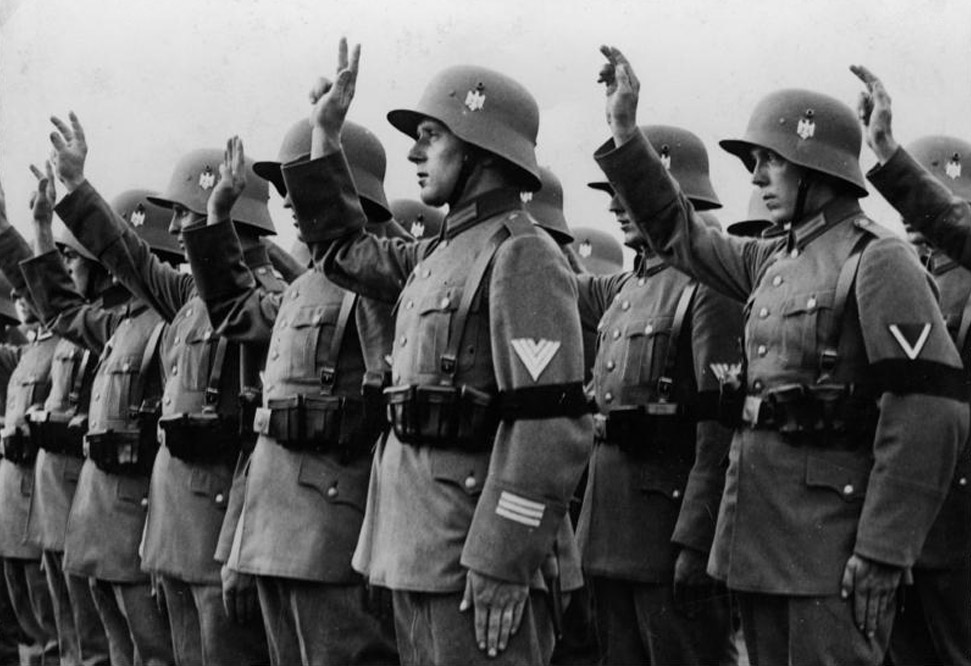
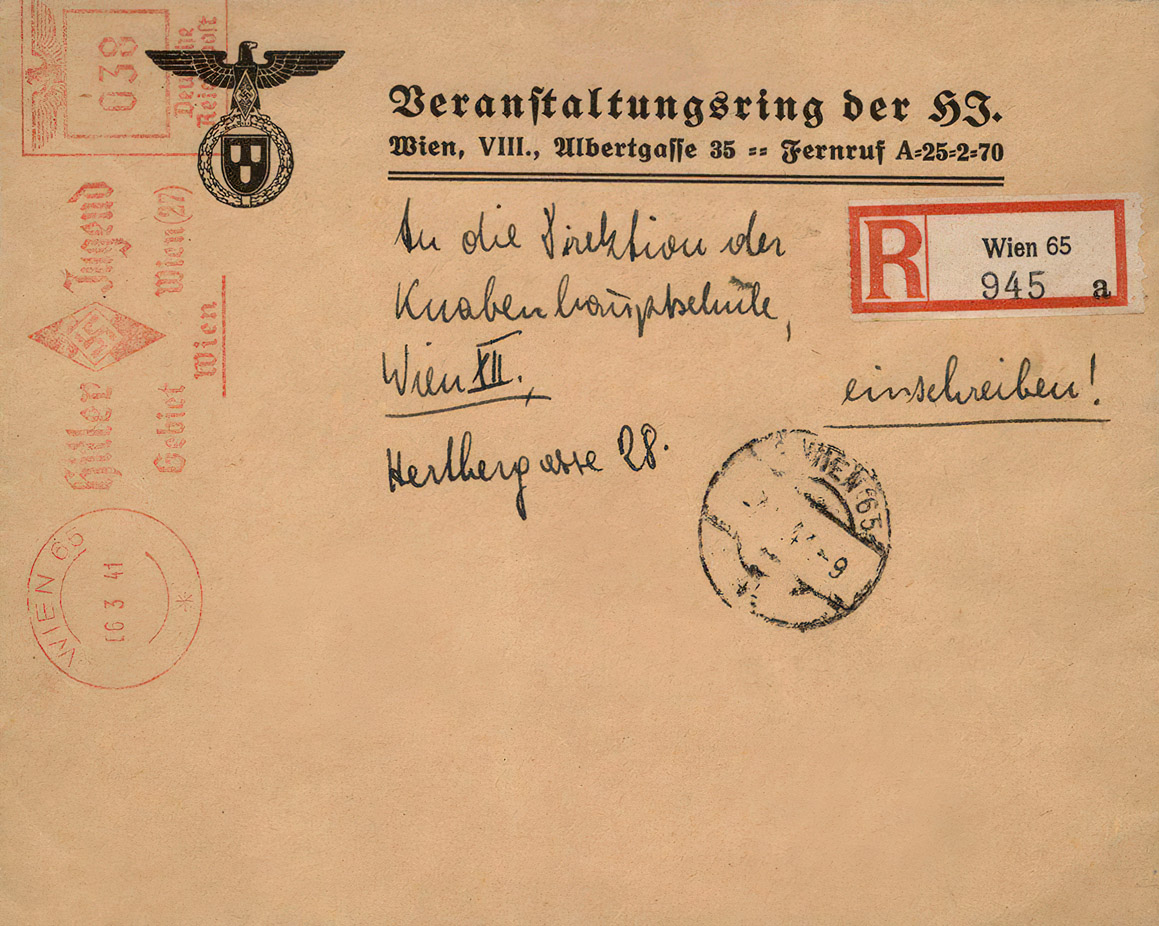
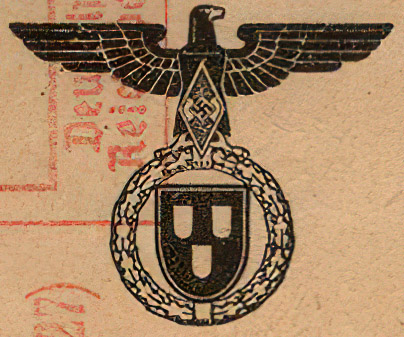
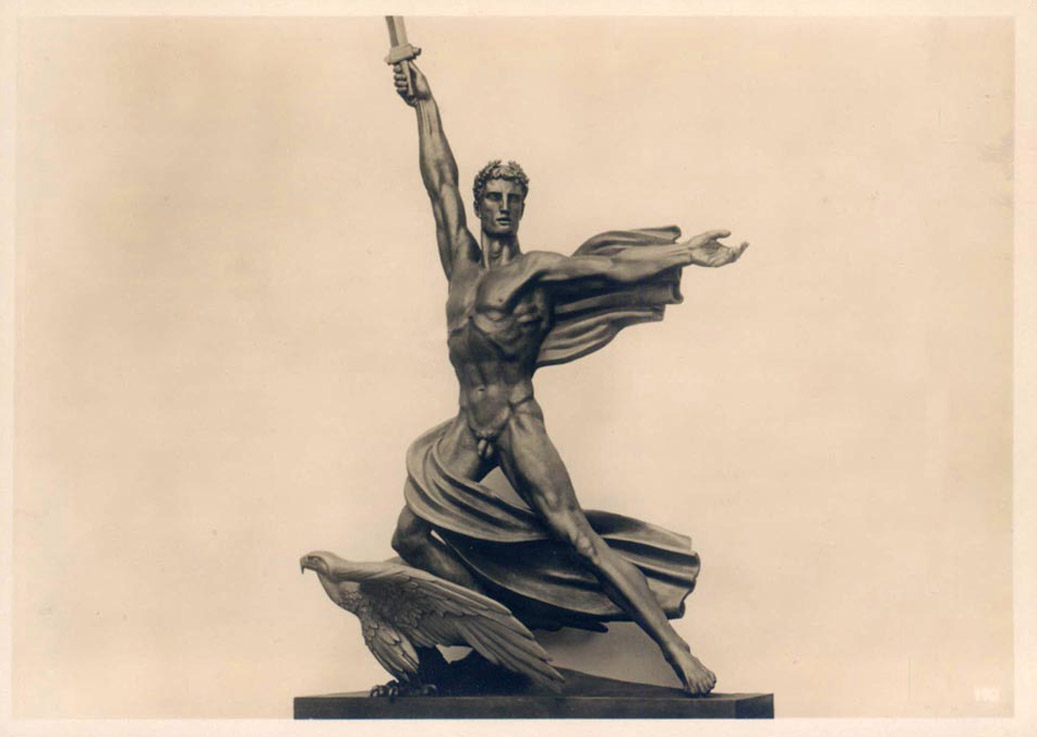
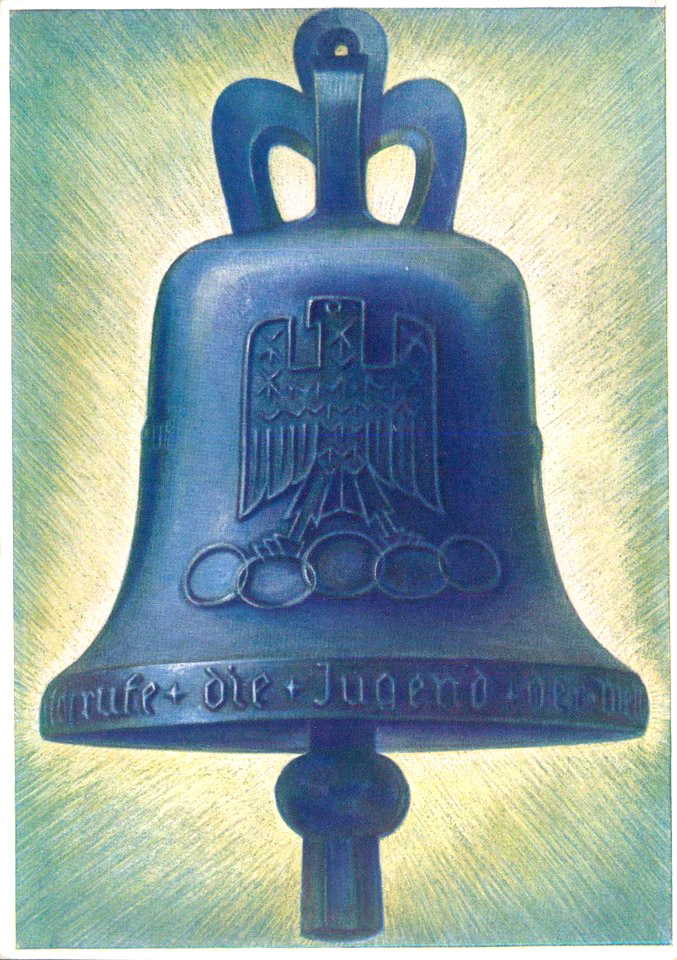
It says 'Olympia-Glocke für die Olympischen Spiele in Berlin 1936
Hergestellt und für die Olympischen Spiele 1936 gestiftet von der ältesten Gußstahl-Glockengießerei der Welt.'
(Olympic bell for the Olympic Games in Berlin 1936 -
Made and donated for the 1936 Olympics by the oldest cast steel bell foundry in the world.)
Bochem is a city in Western Germany with a history of mining and steel production.]
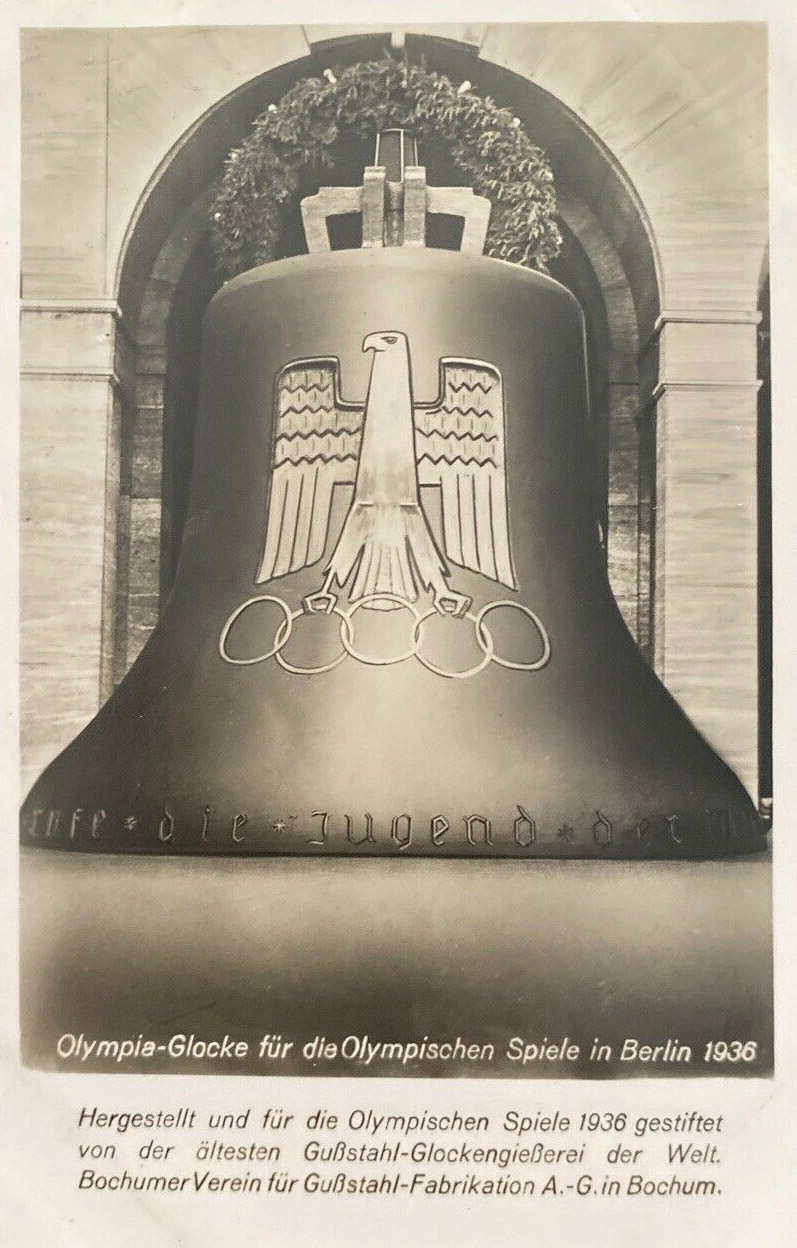
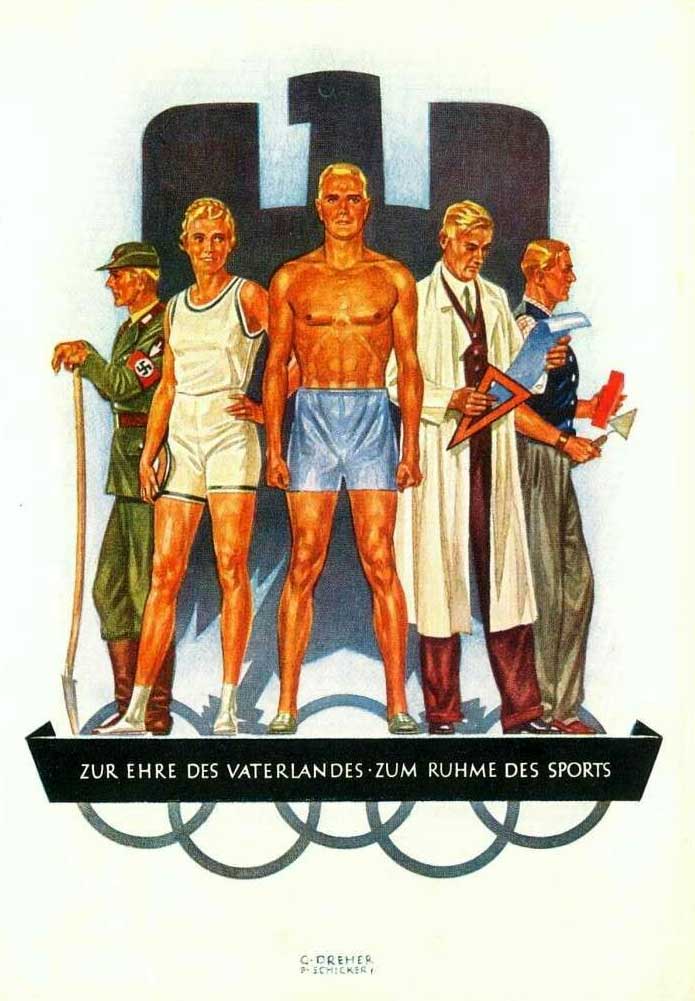
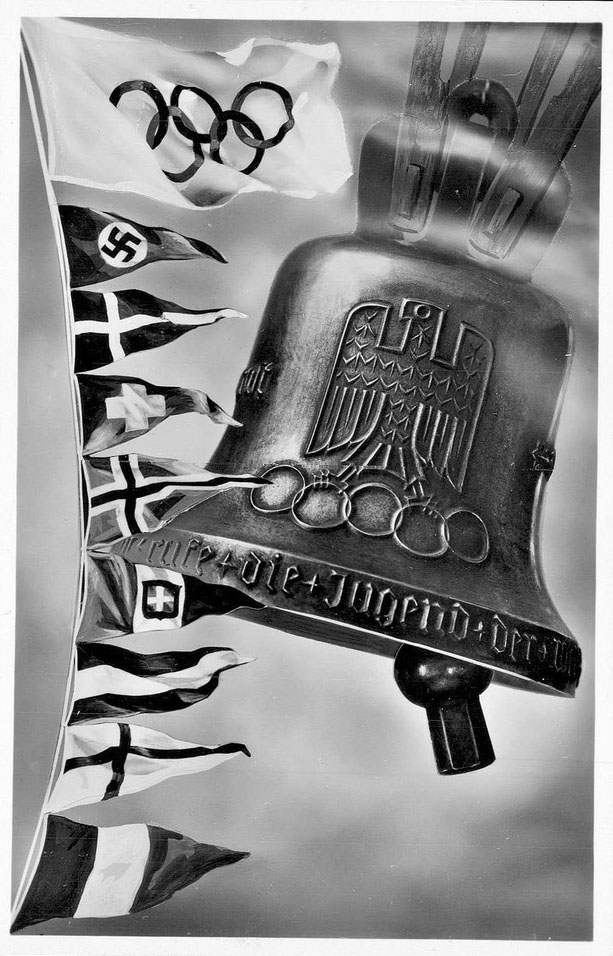
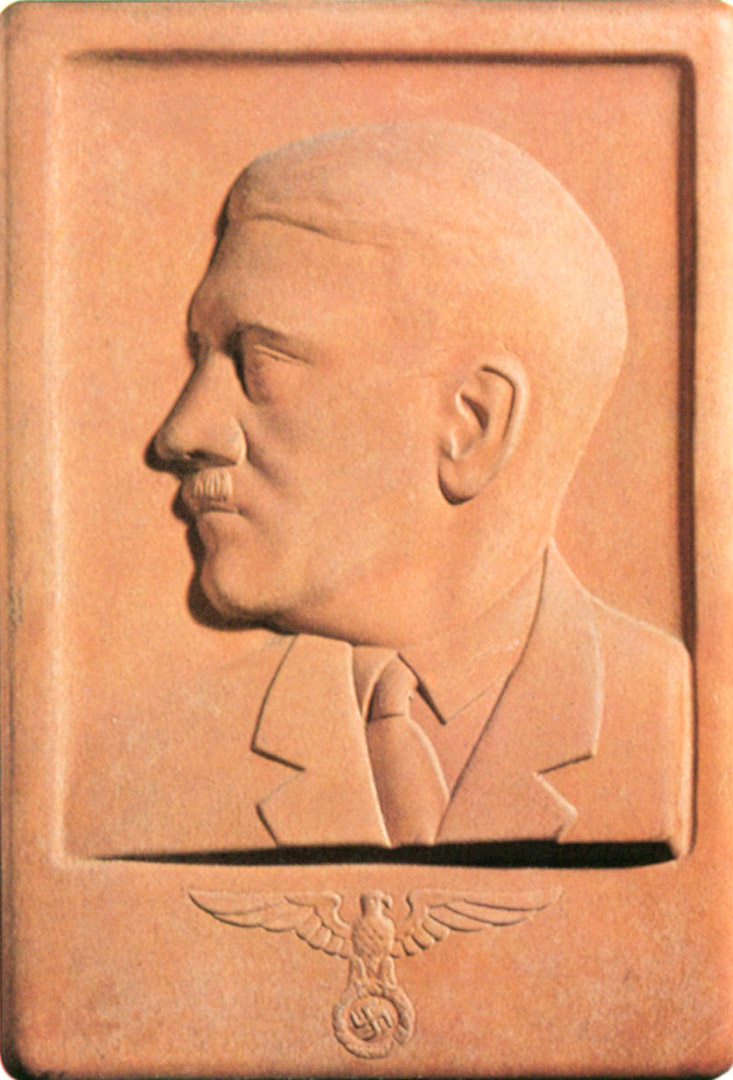
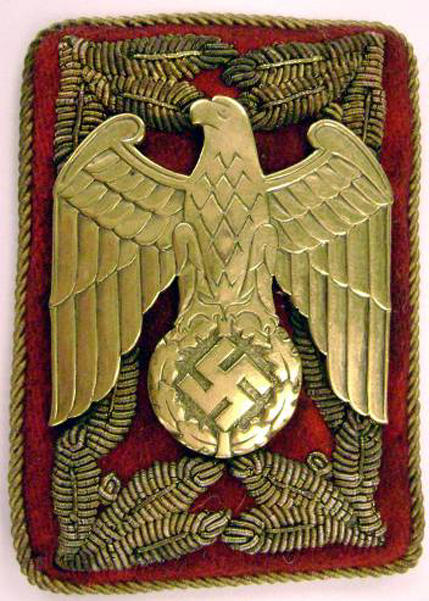
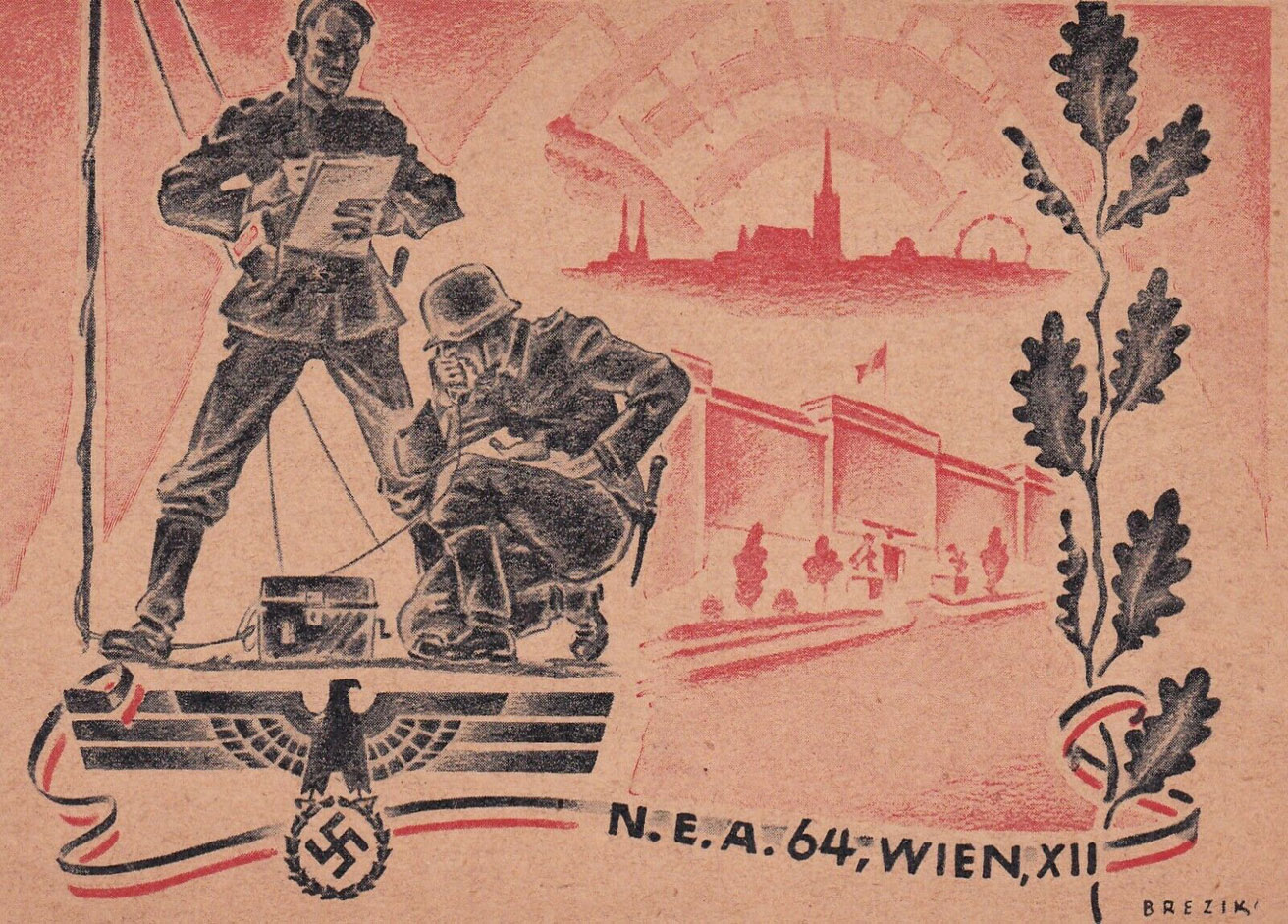
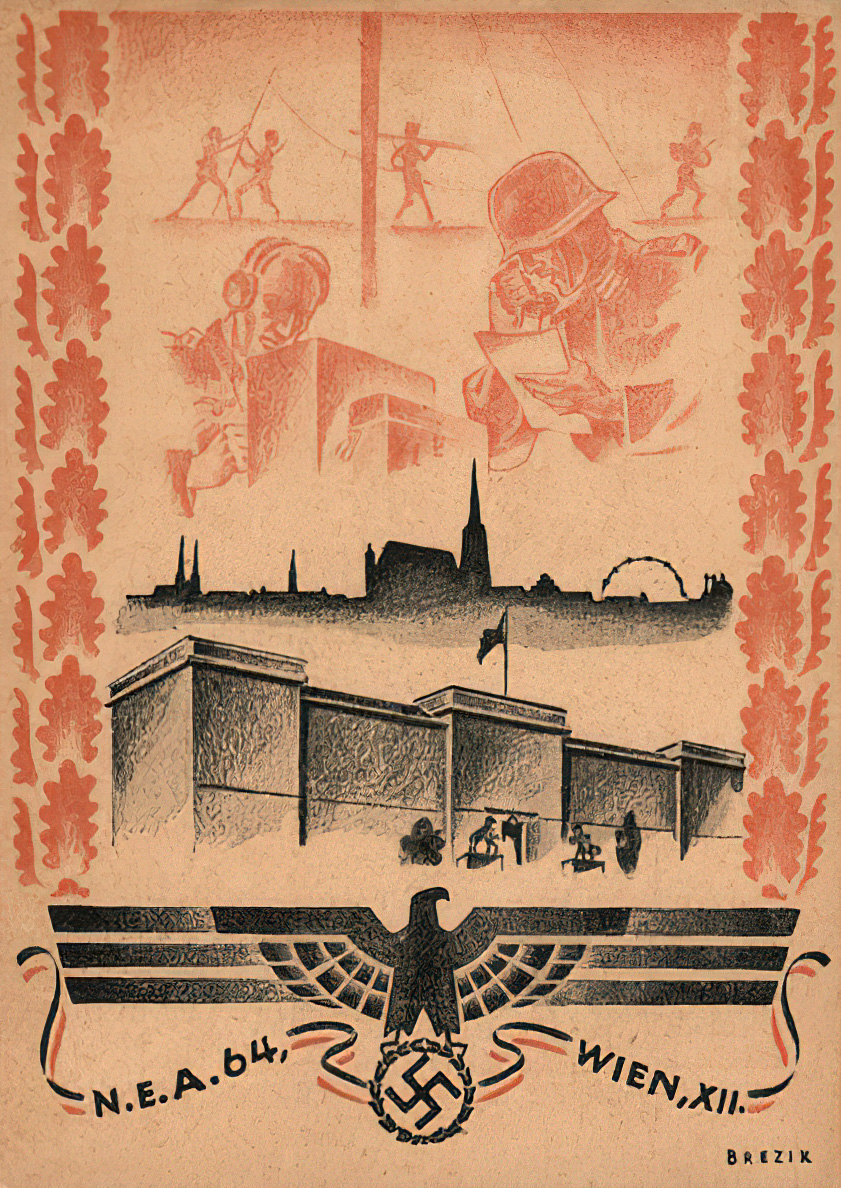
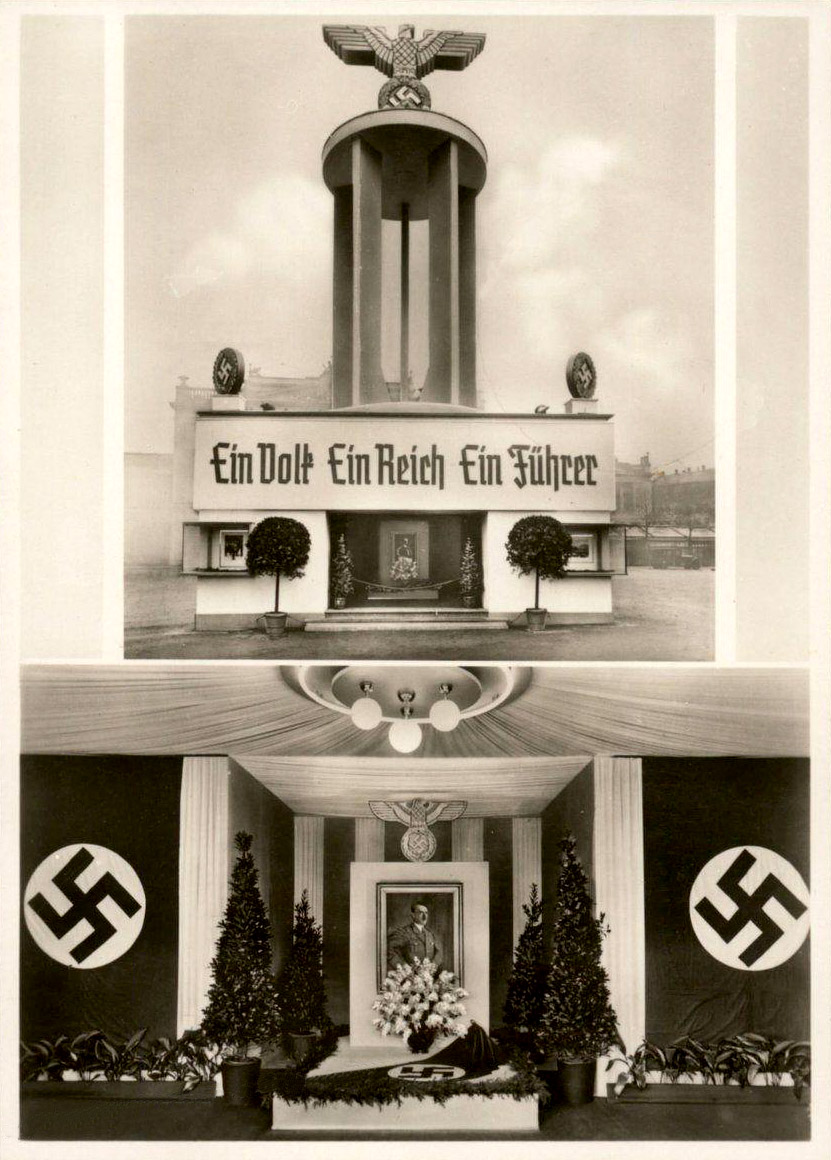
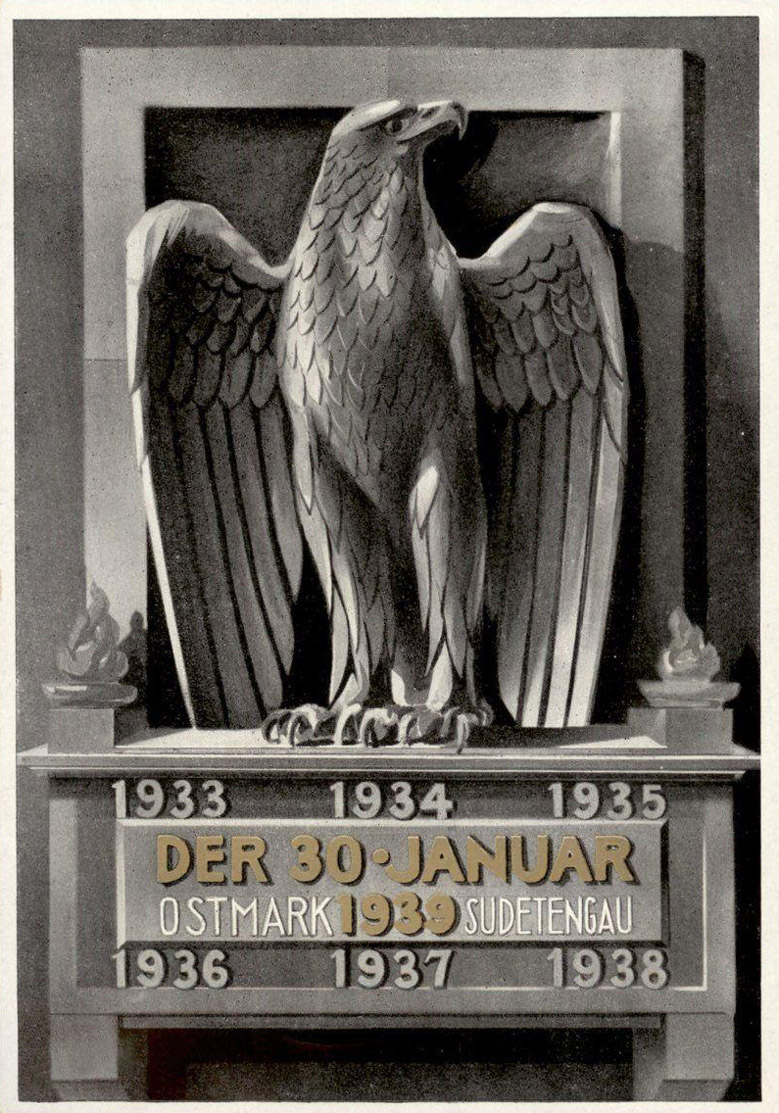
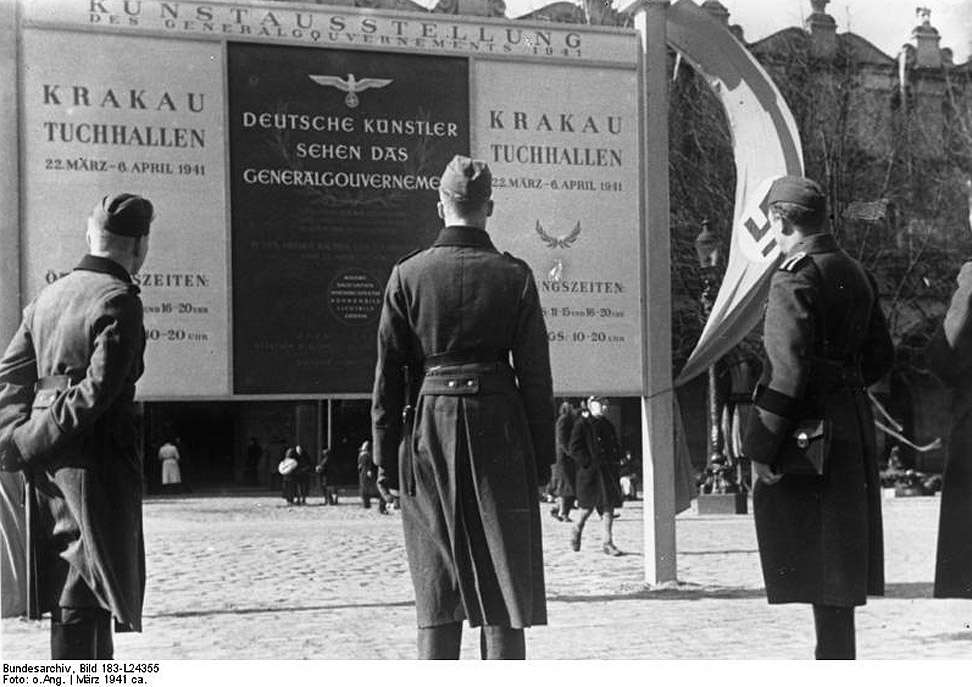
für 60 Tausend Volksgenossen
in der Pflaz
Das erste Hitler jahr
führte 18 Tausend
der Arbeit zu.
Nun gilt es zweite
jahr zu ein em jahr des
Erfolgeszumachen
Deshalb:
an jeden leerstehenden
Arbeitsplatz einen
erwerbslosen Volksgenossen
jeder helfe mit und
wir gewinnen die
Arbeitsschlacht.'
for 60 thousand comrades
in the Palatinate (a region of Germany)
The first year of Hitler
led 18 thousand
to work.
Now it is necessary to make the second year a year of
success.
Therefore:
To every vacant
workplace one
unemployed comrade
of the people, everyone helps and
we win the
battle of labor).]
